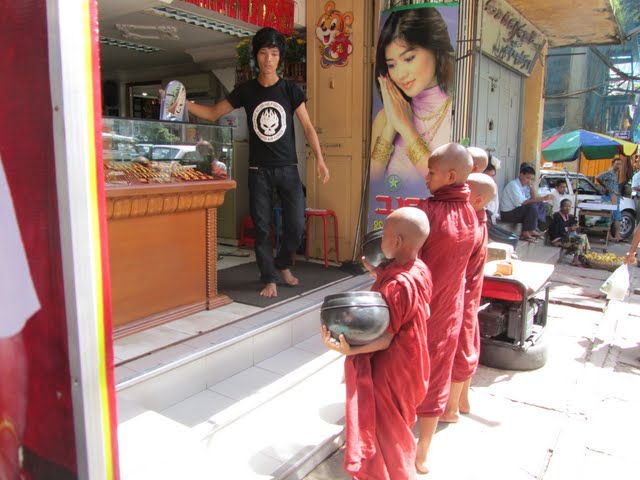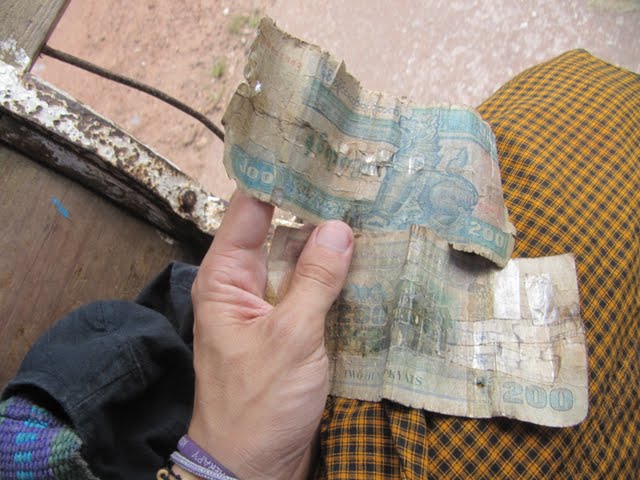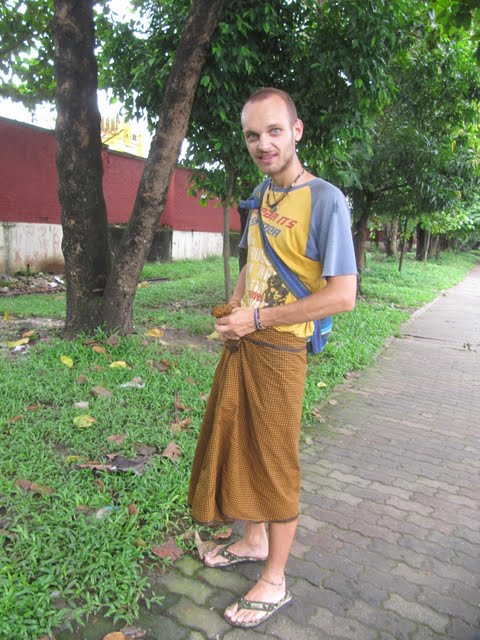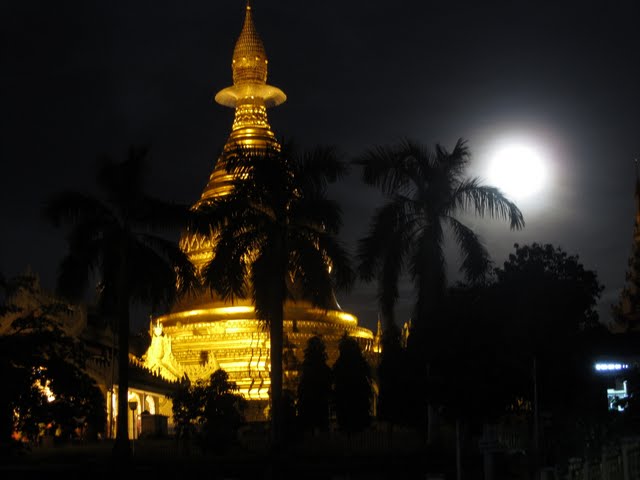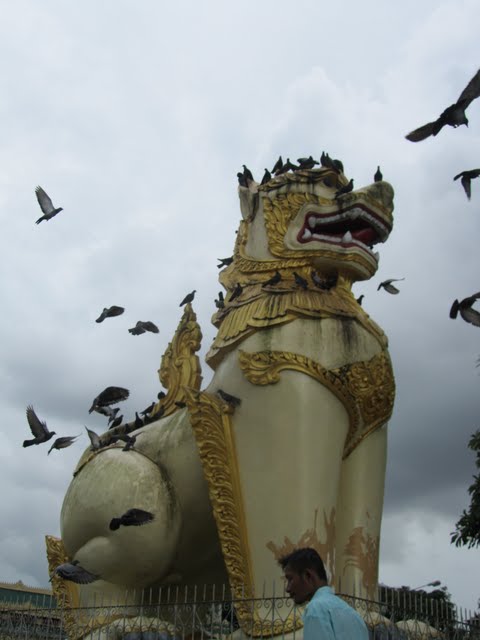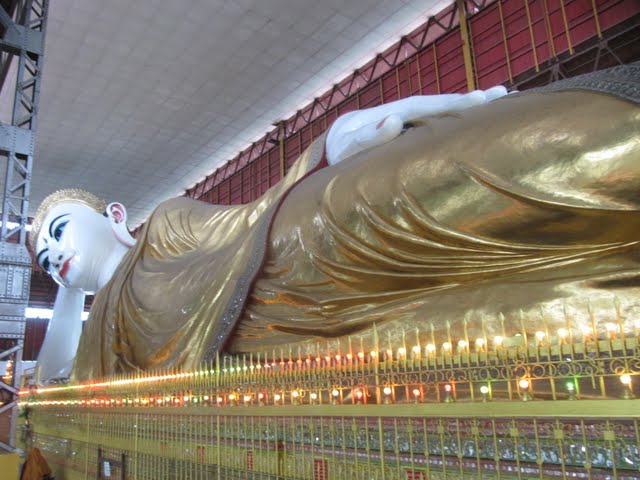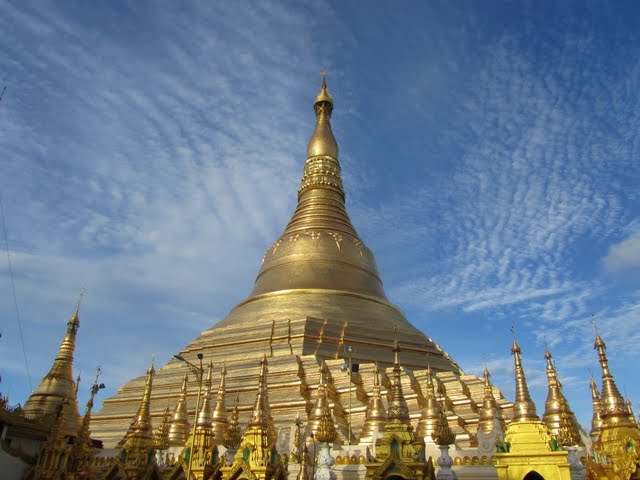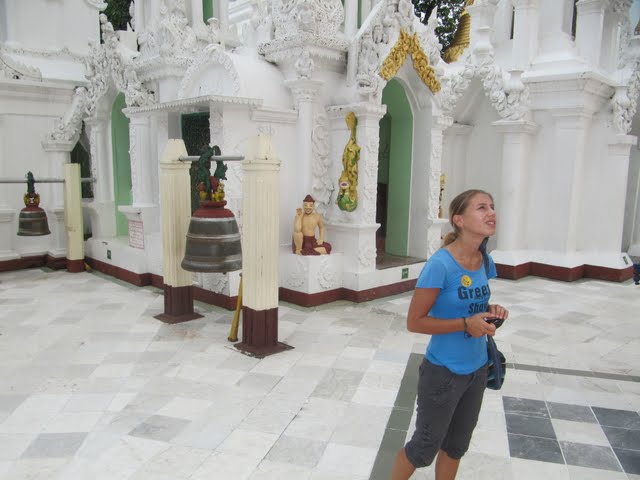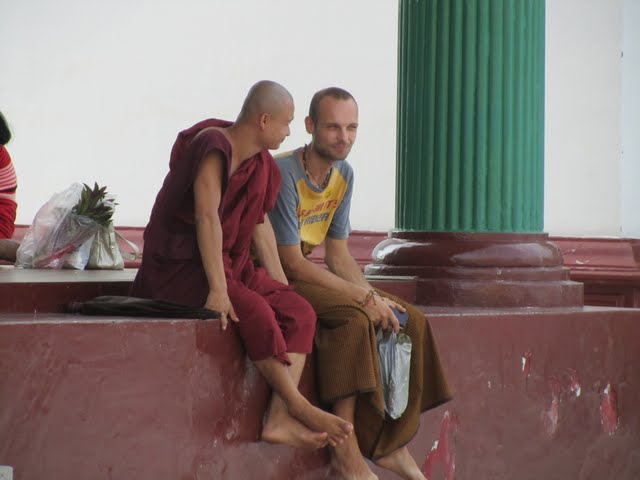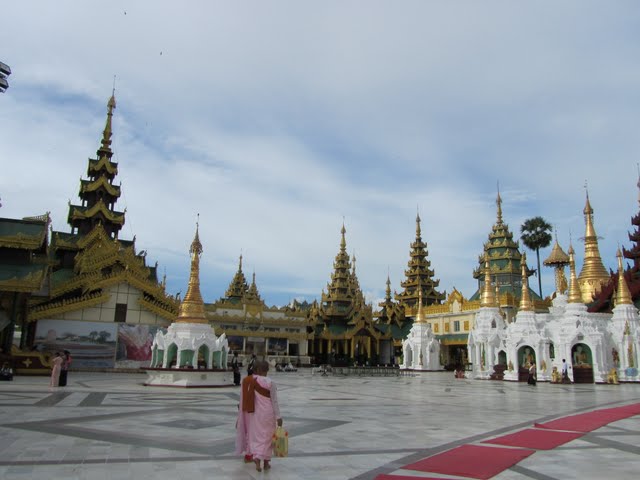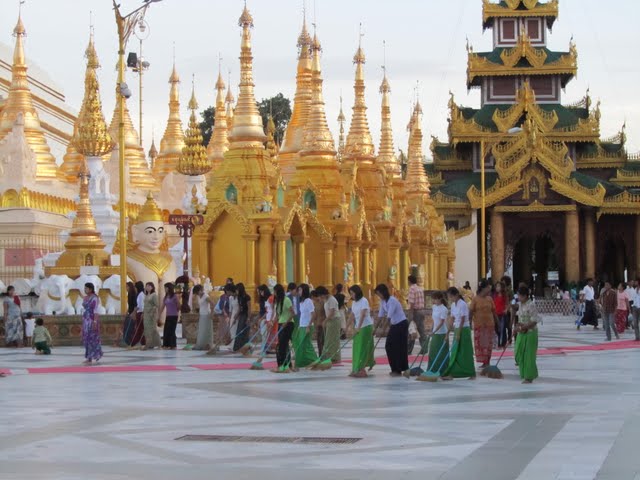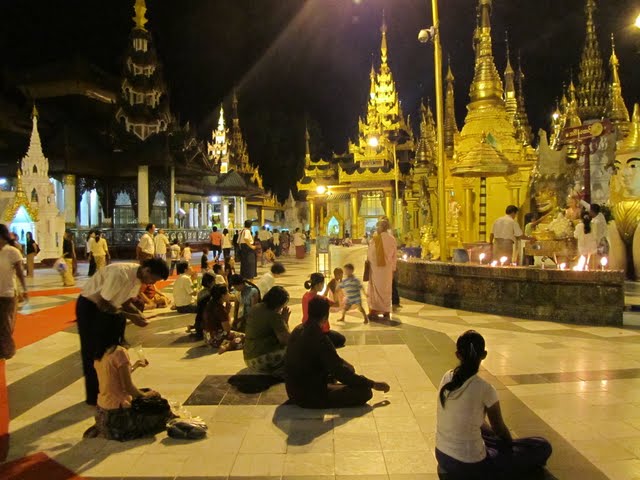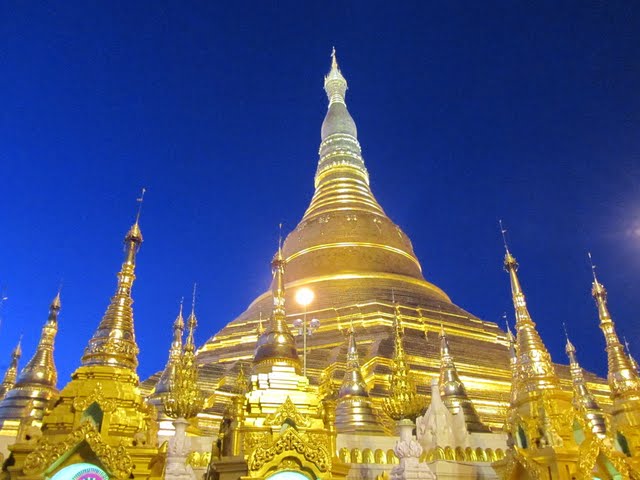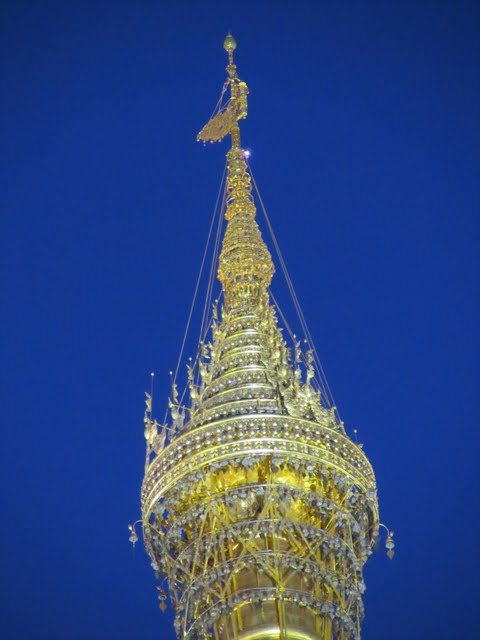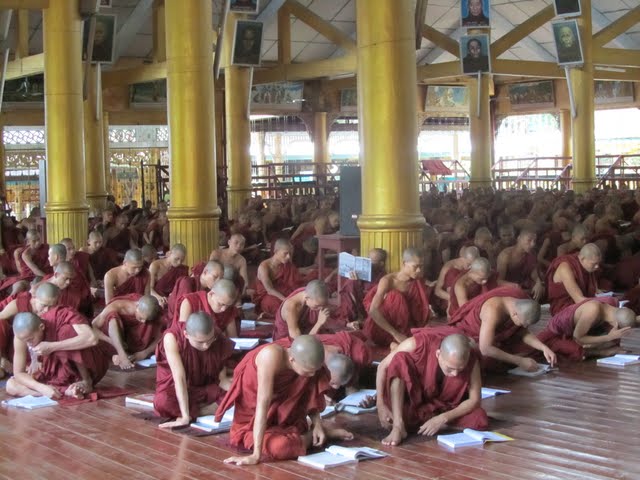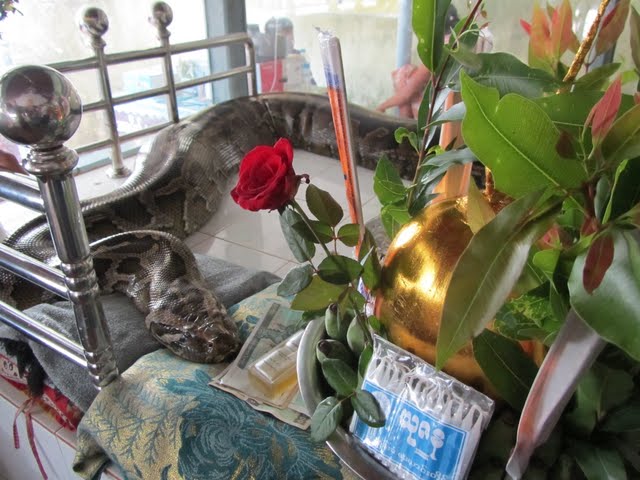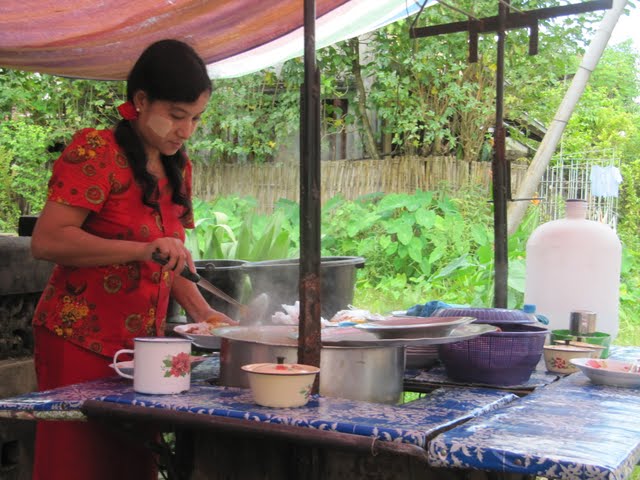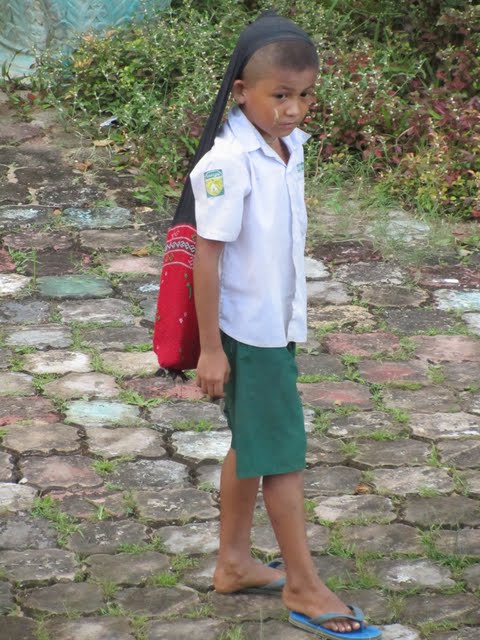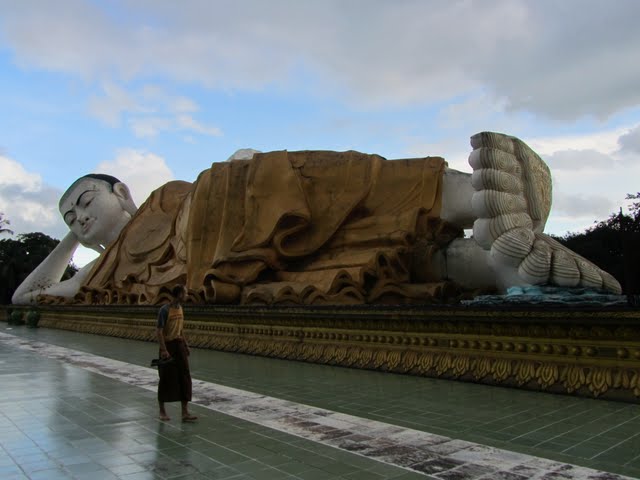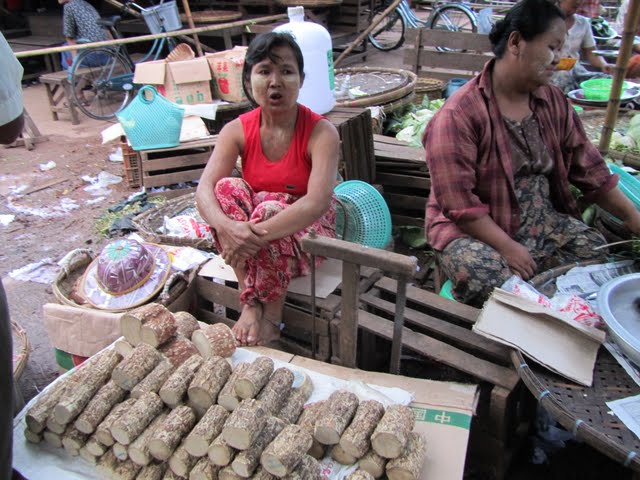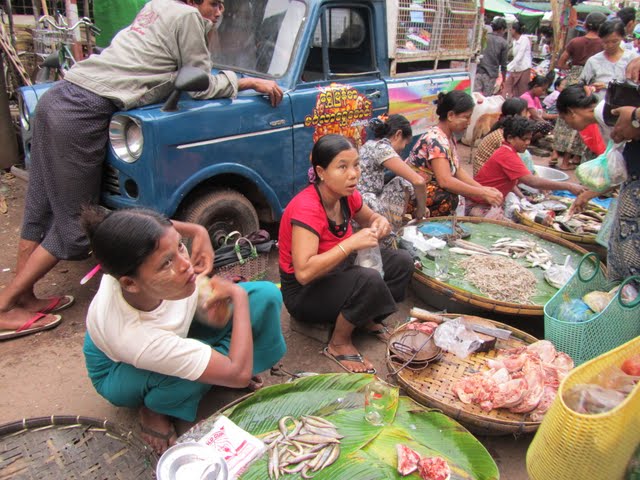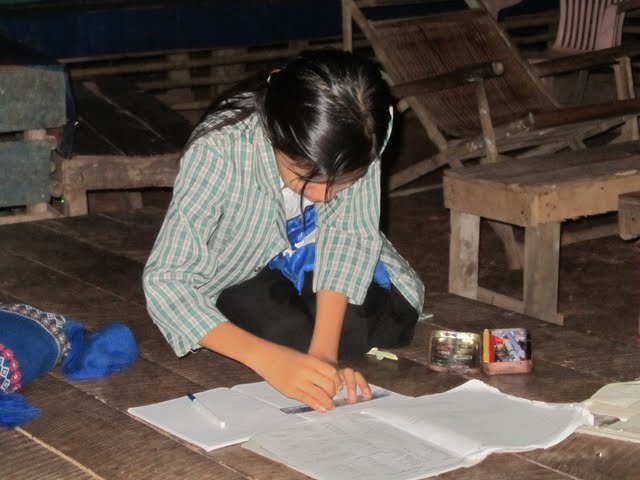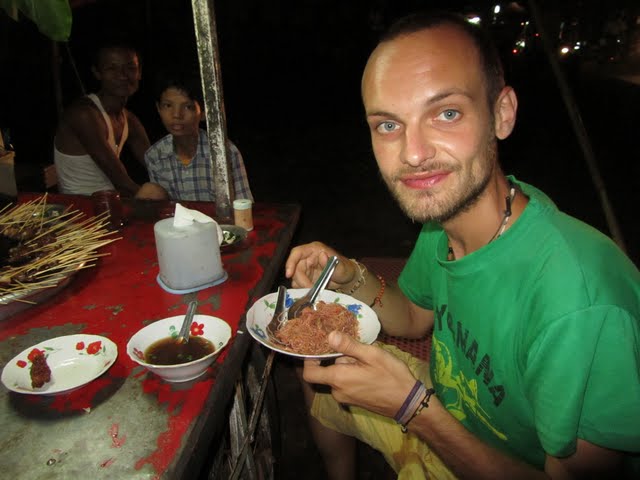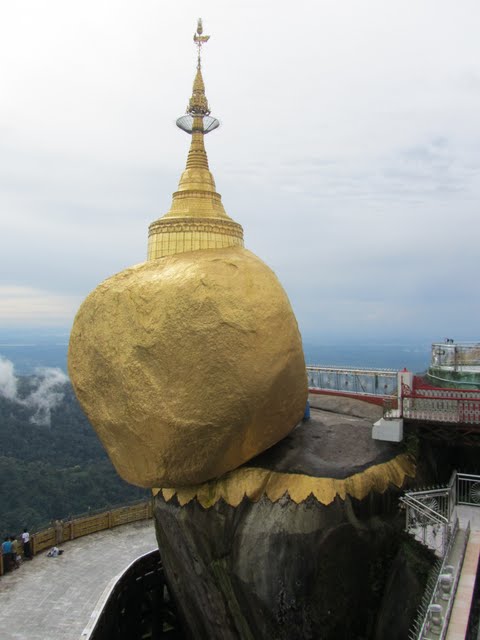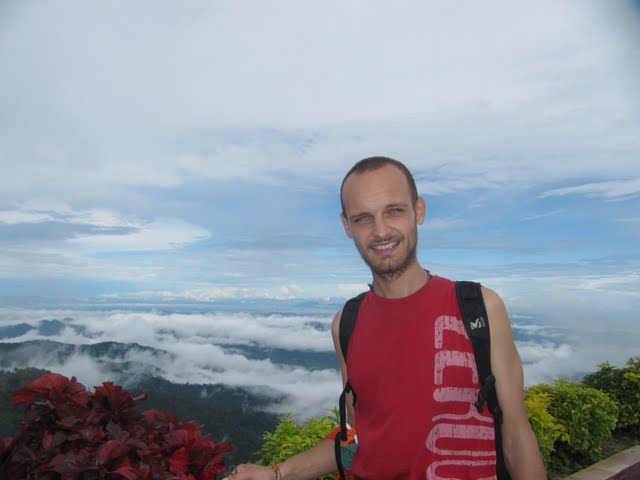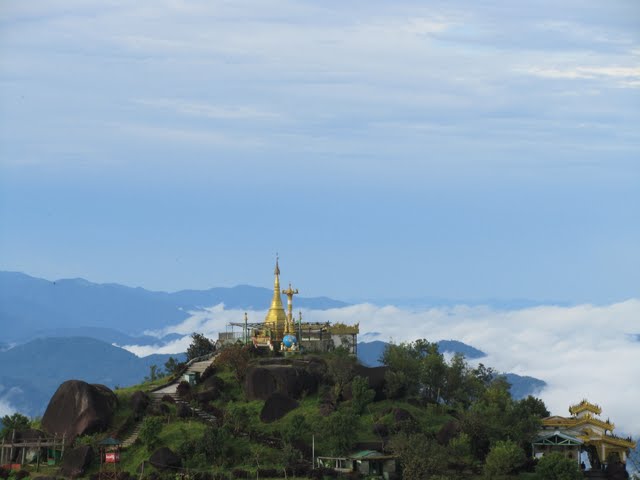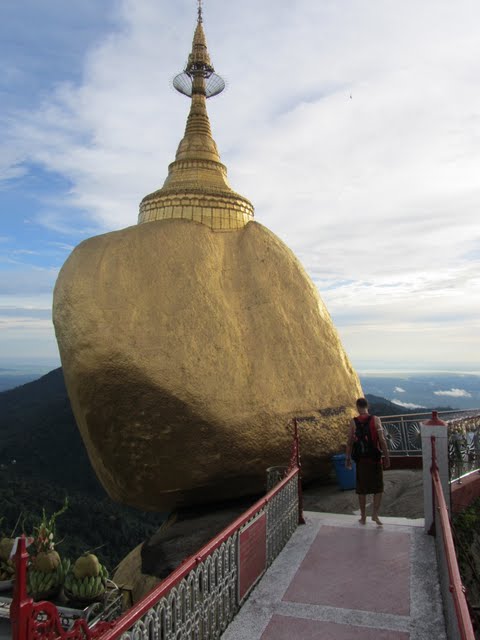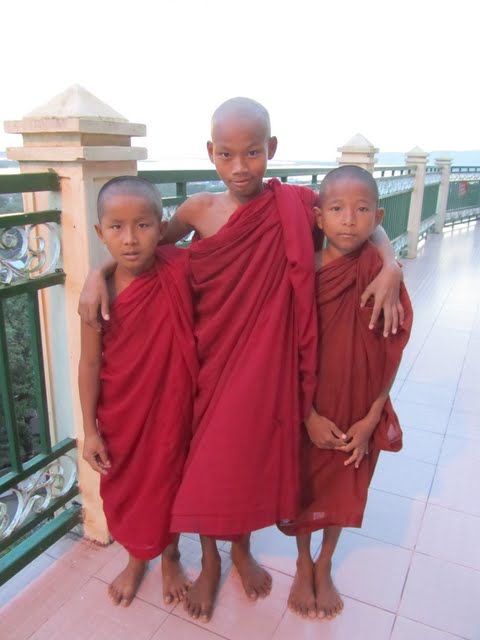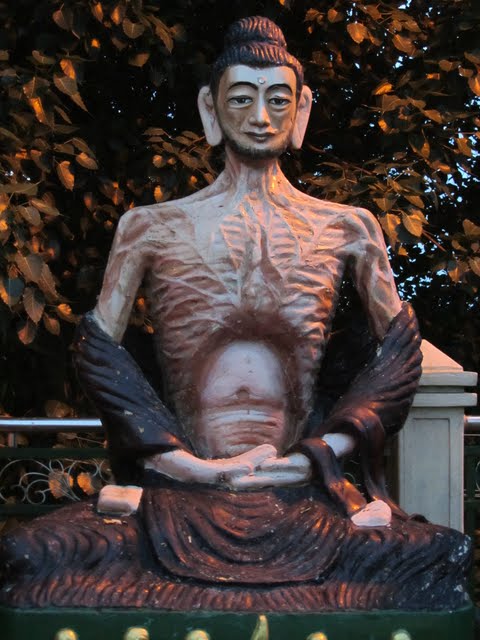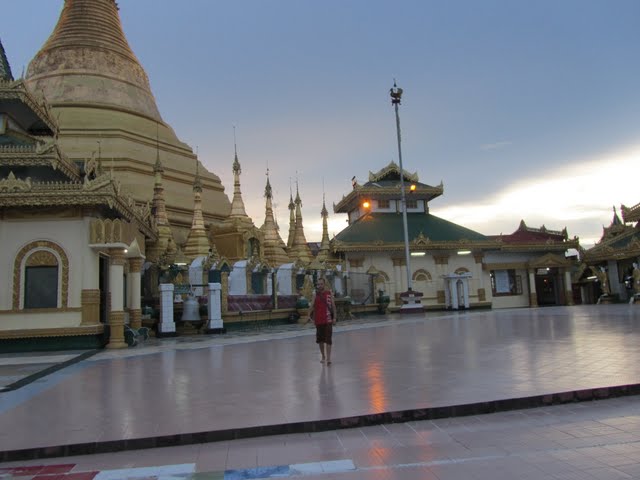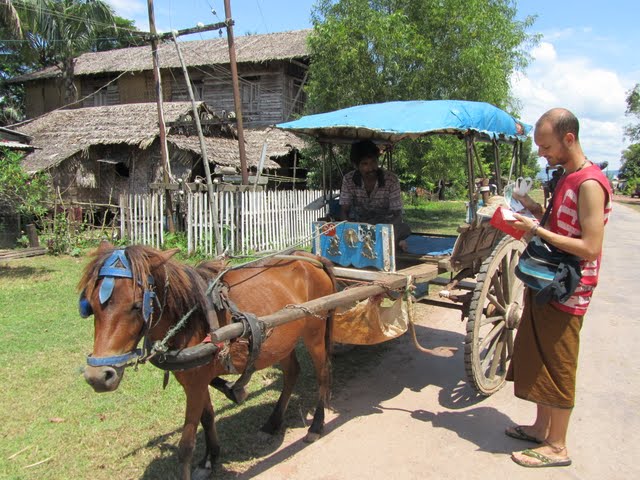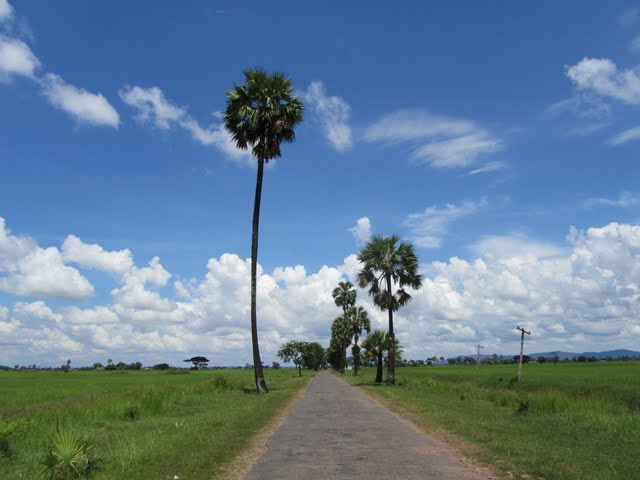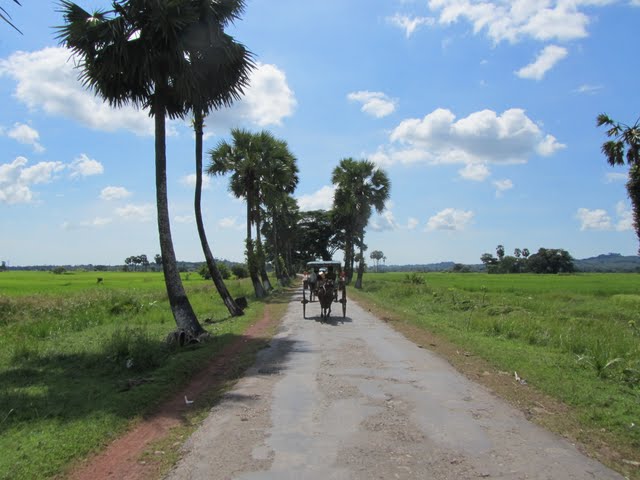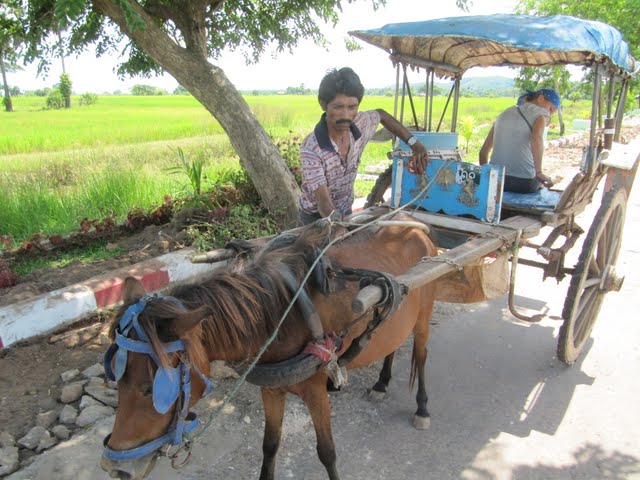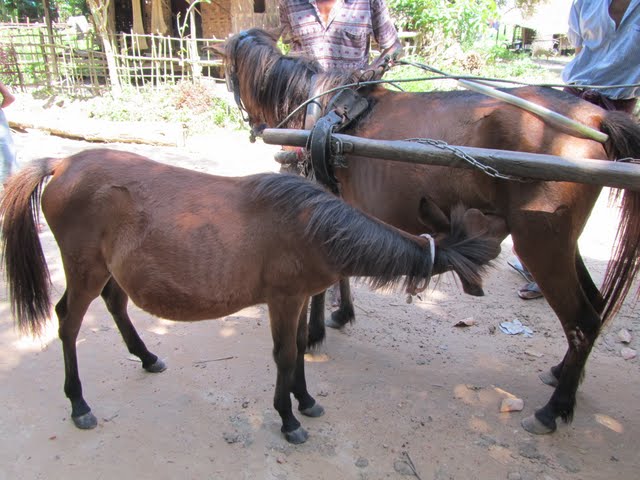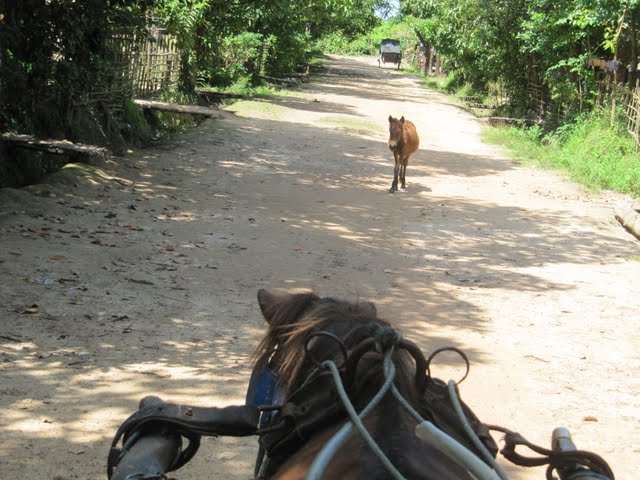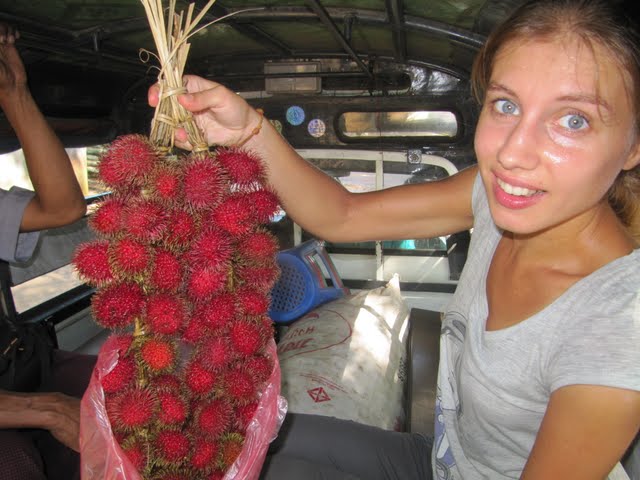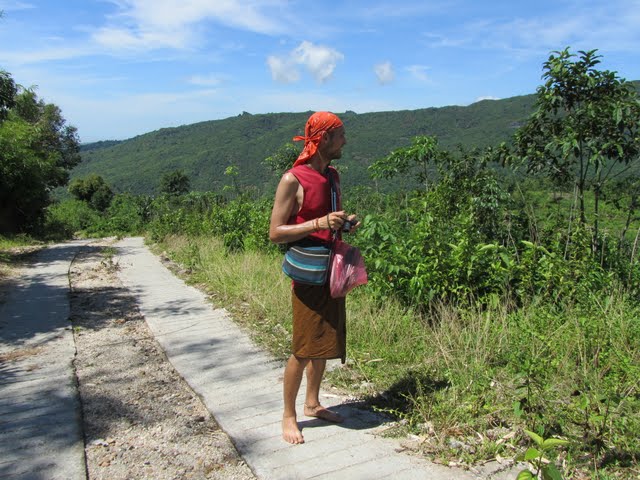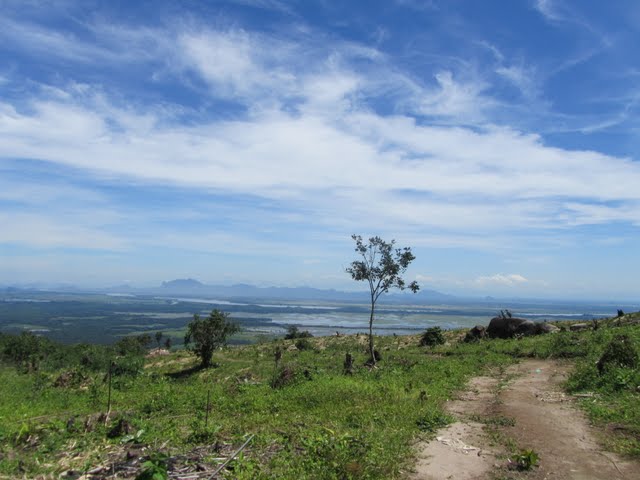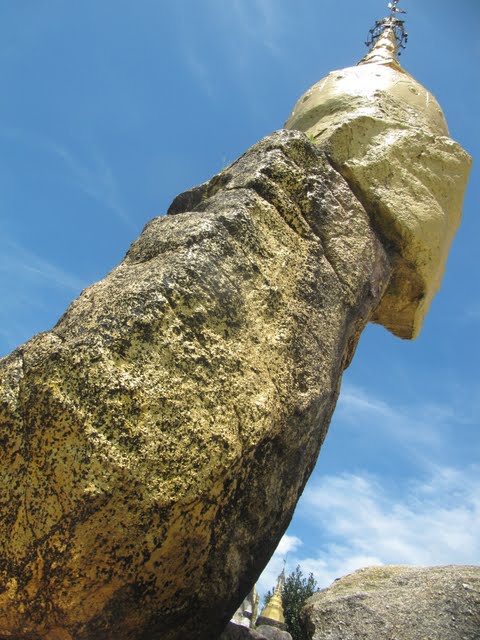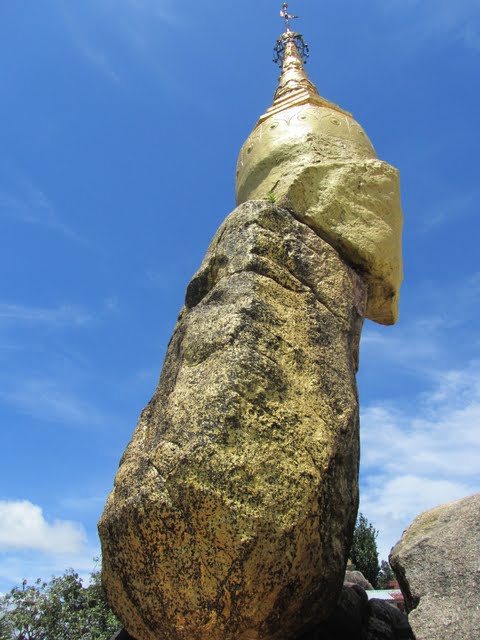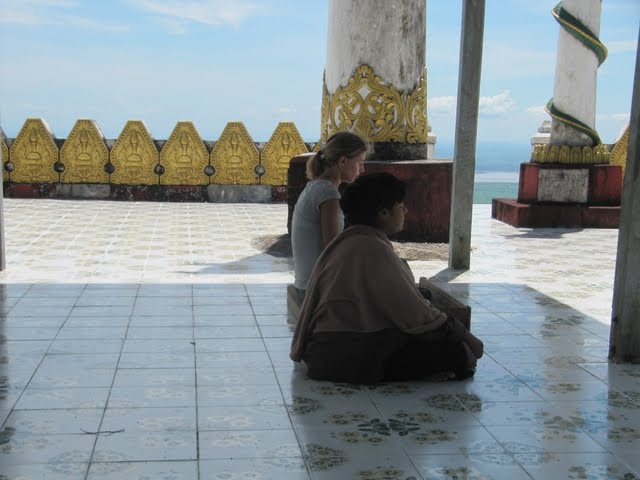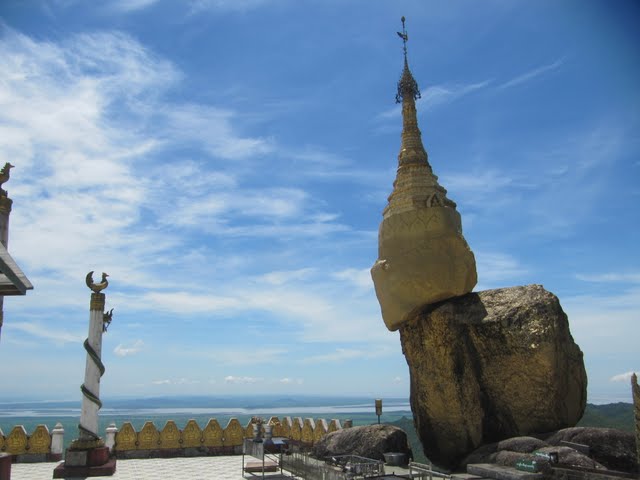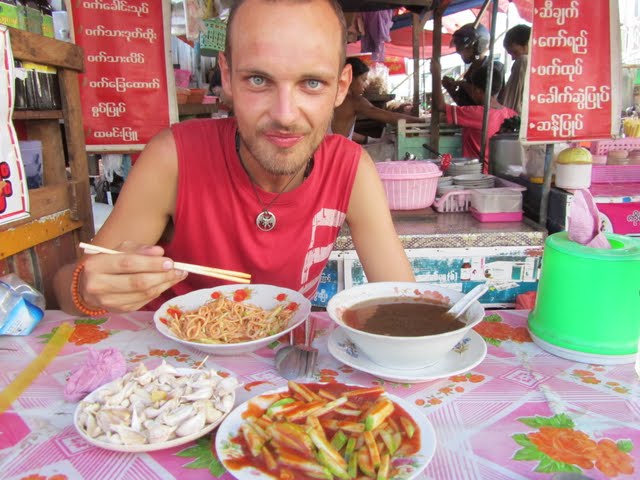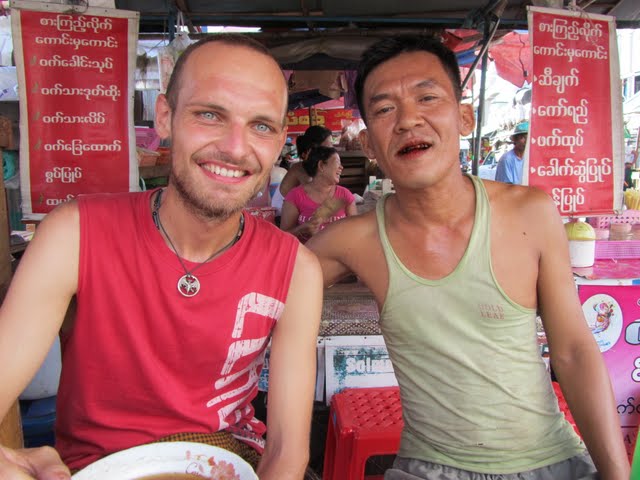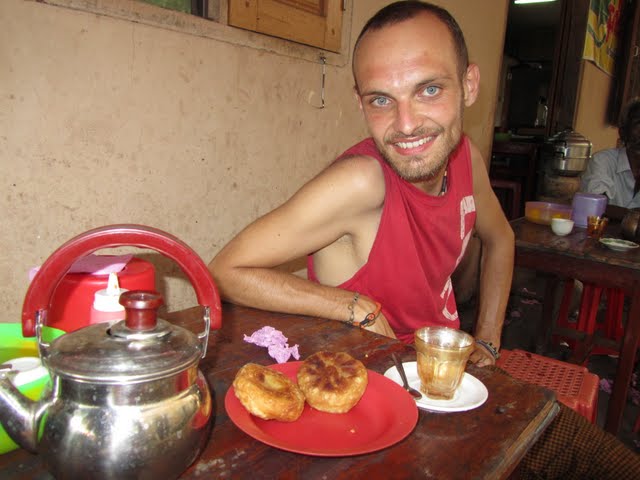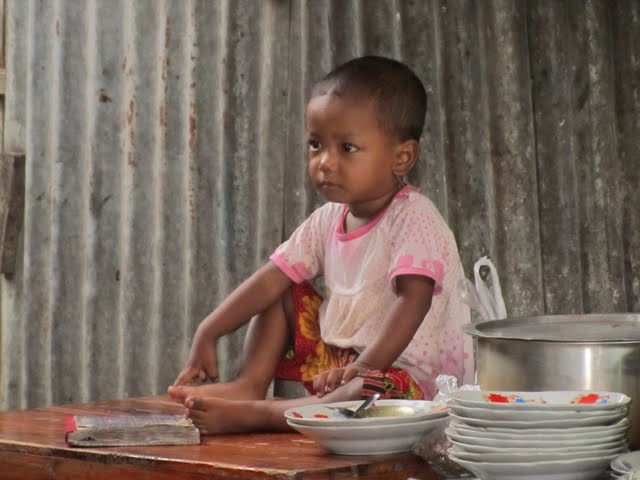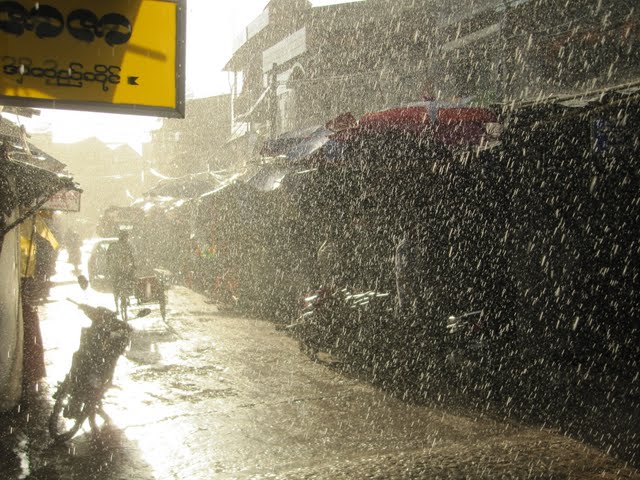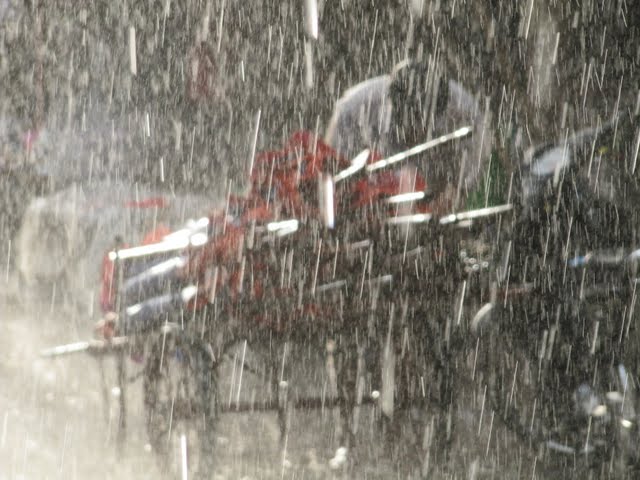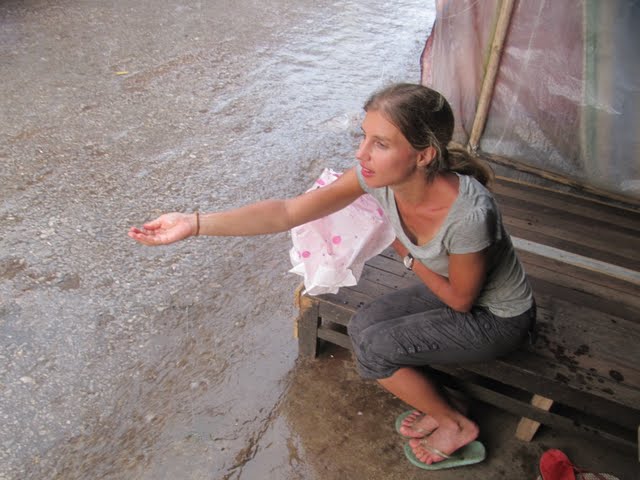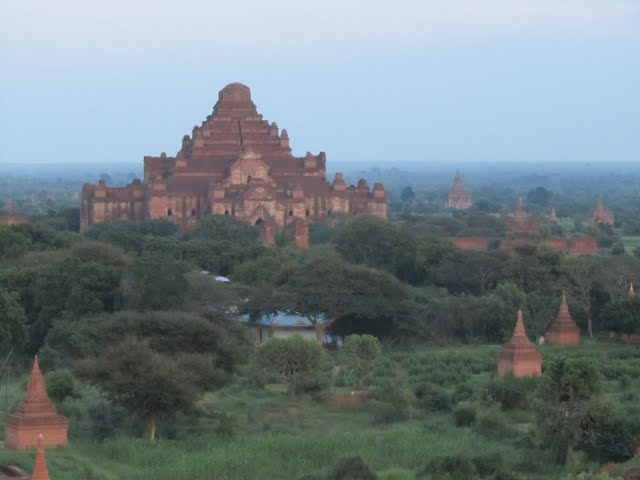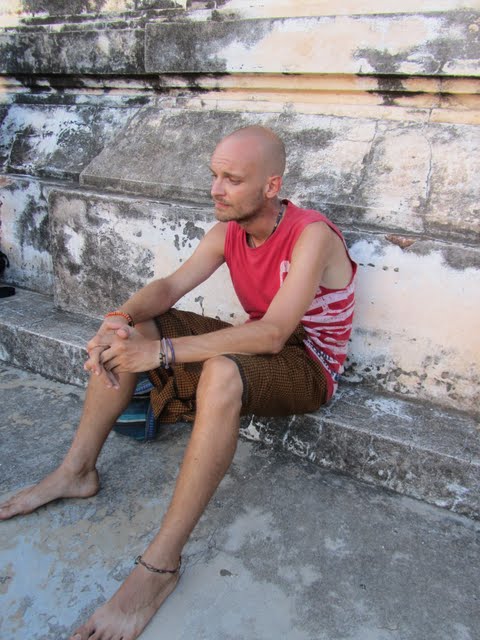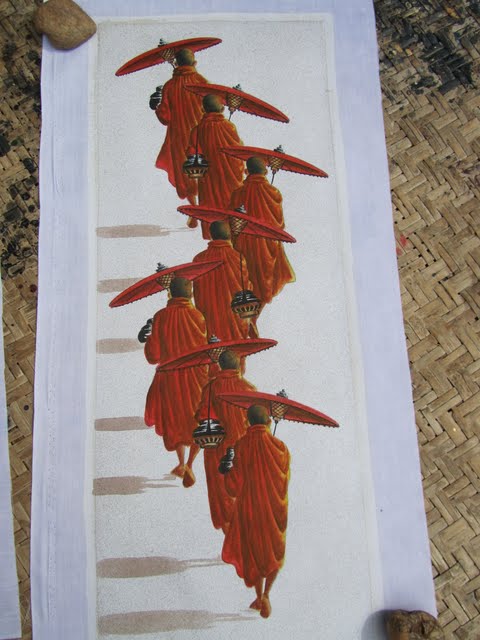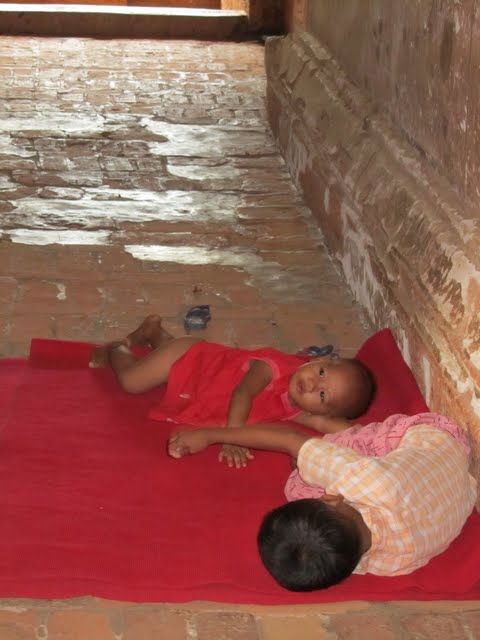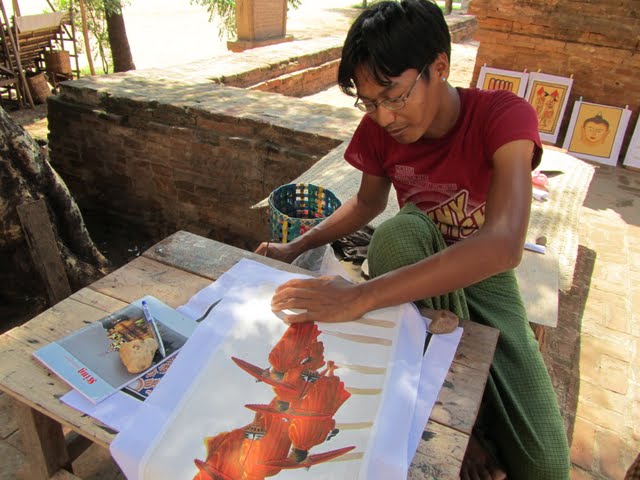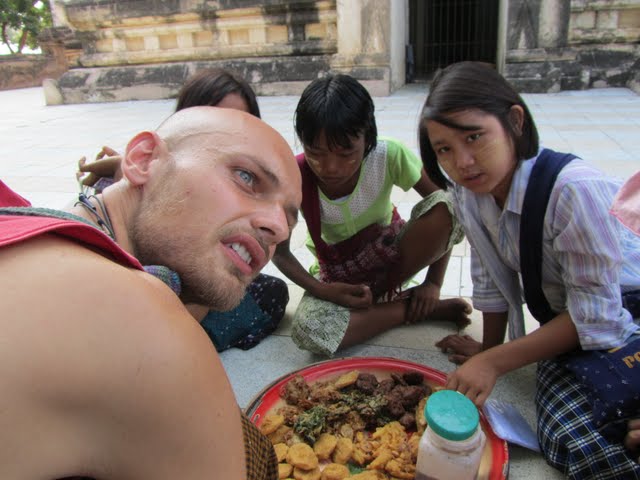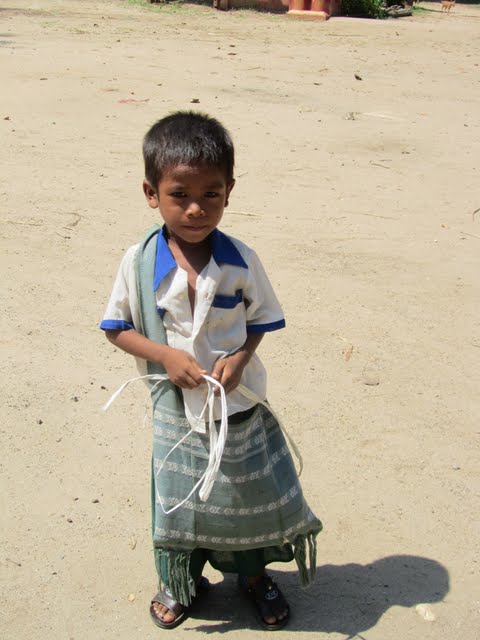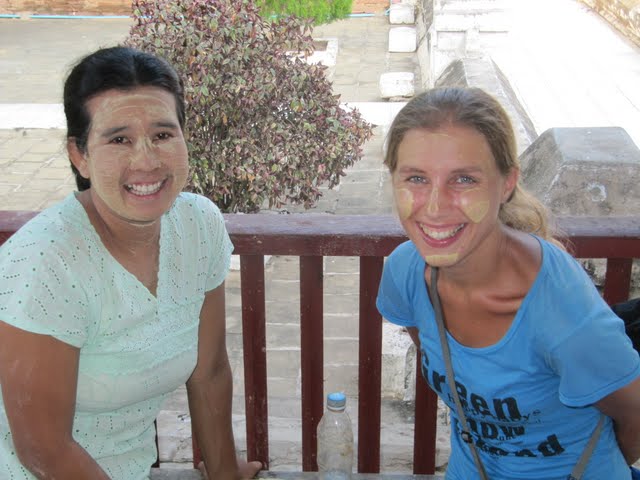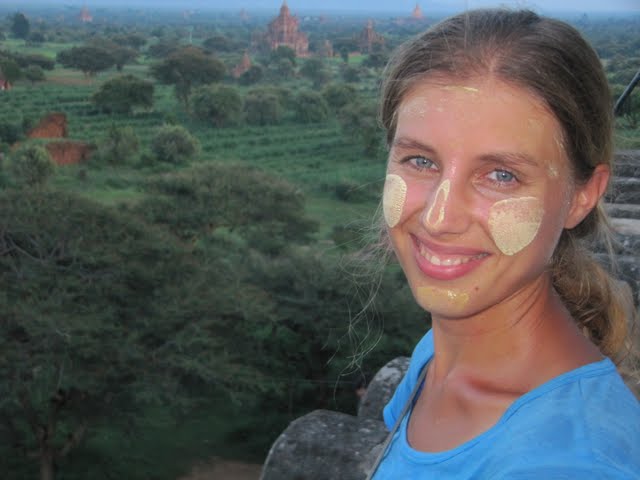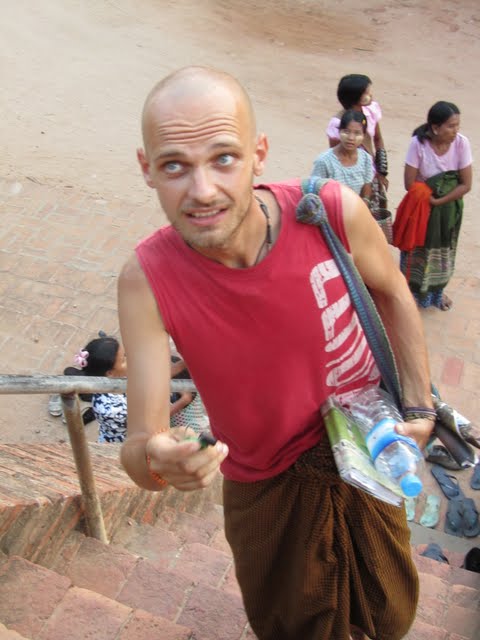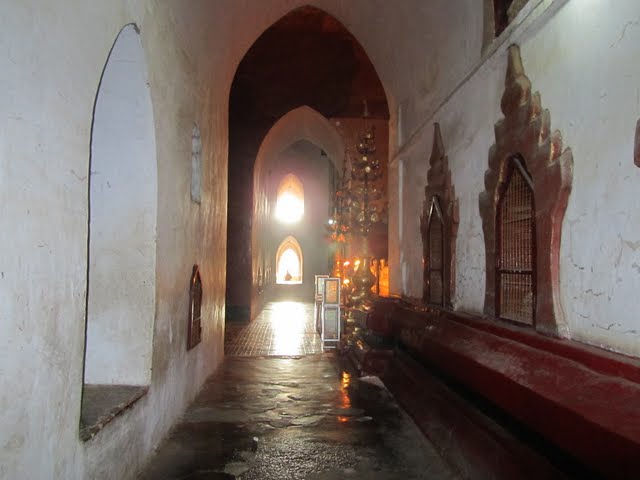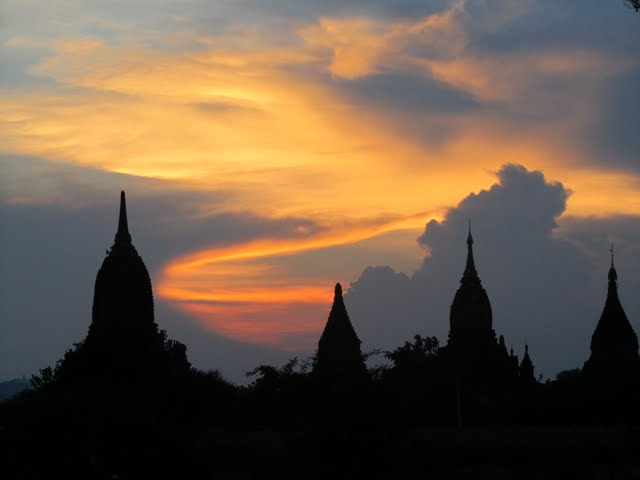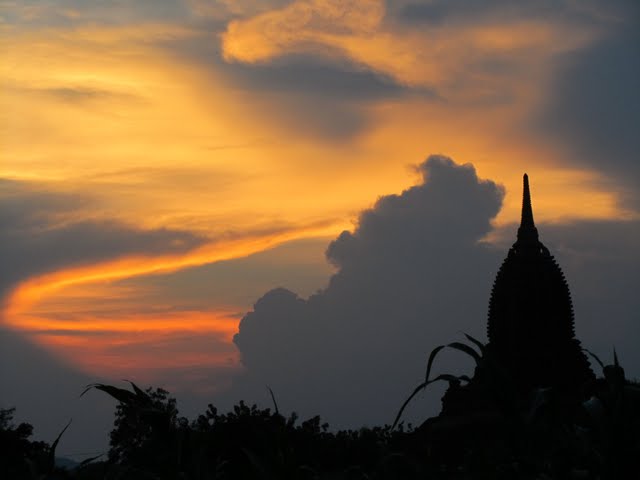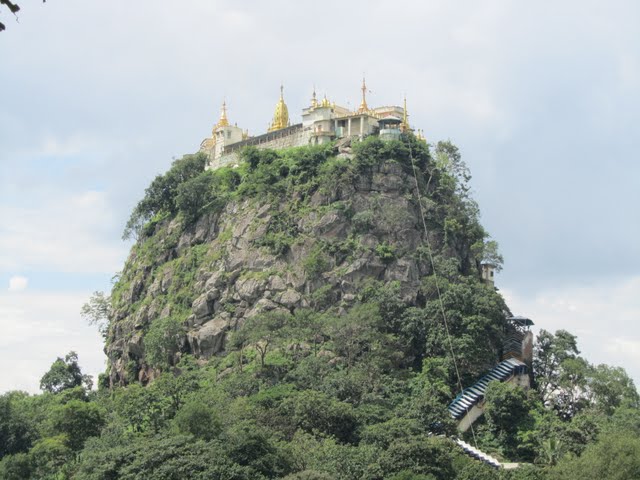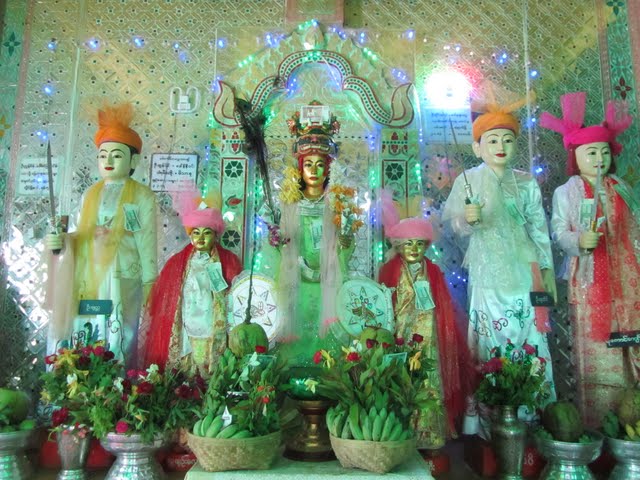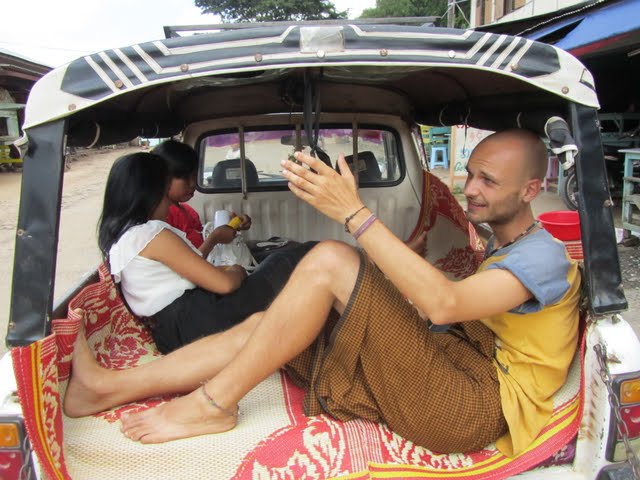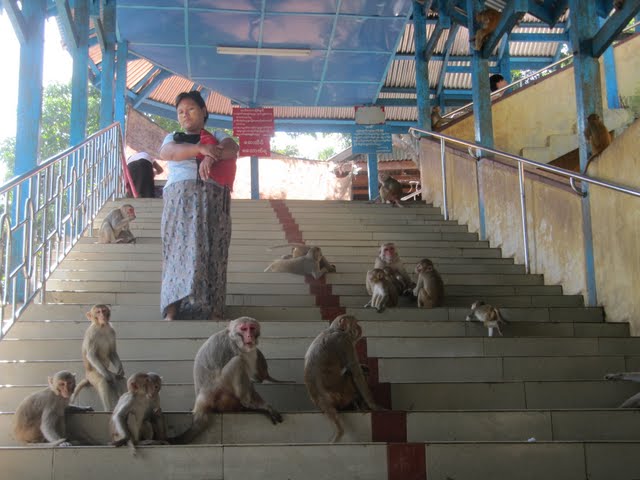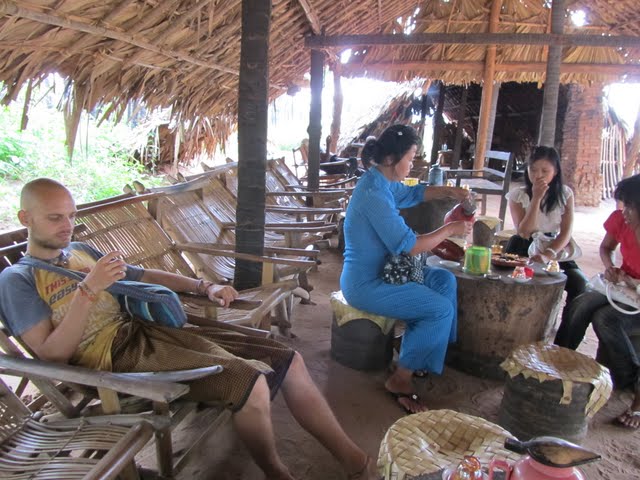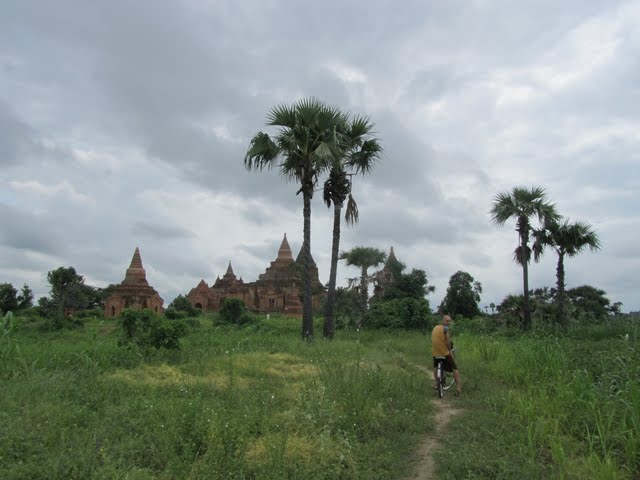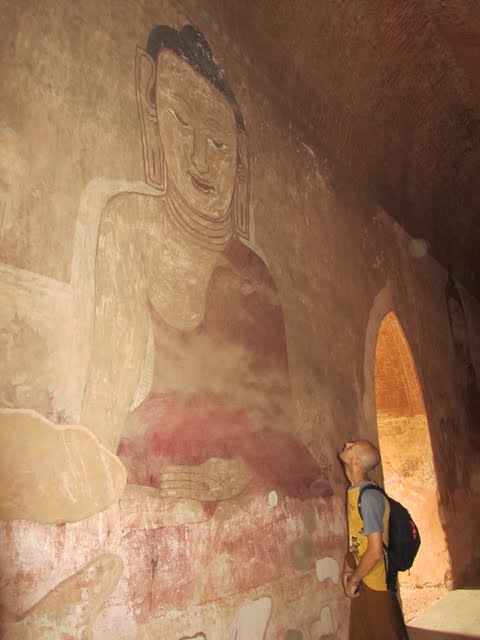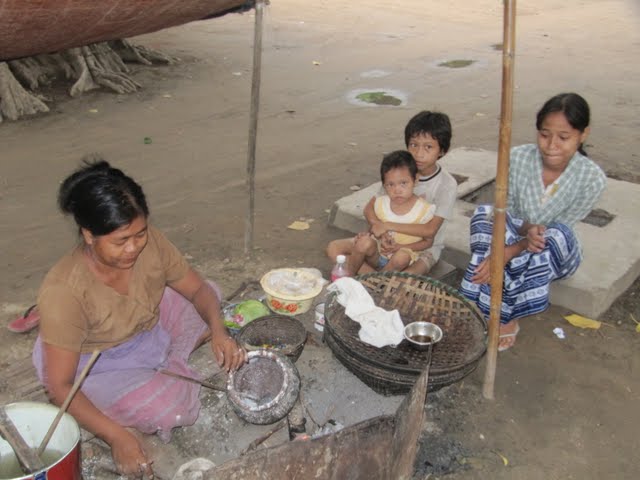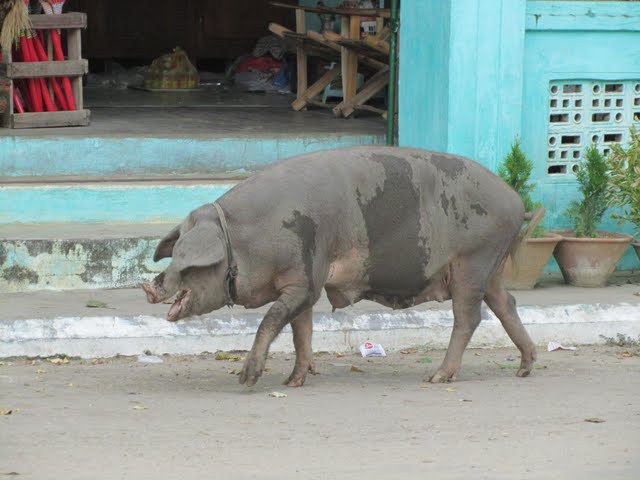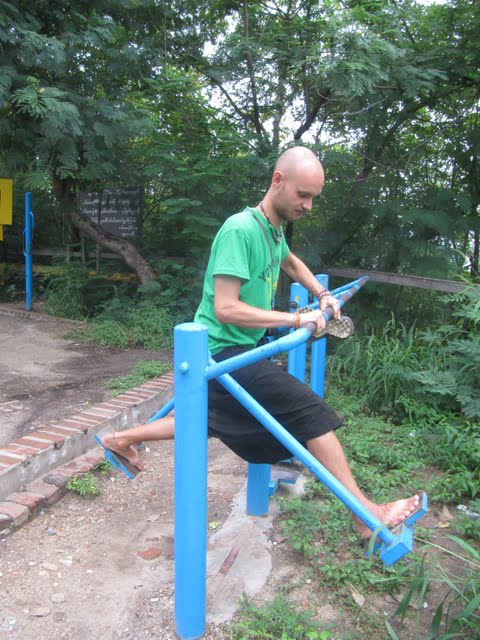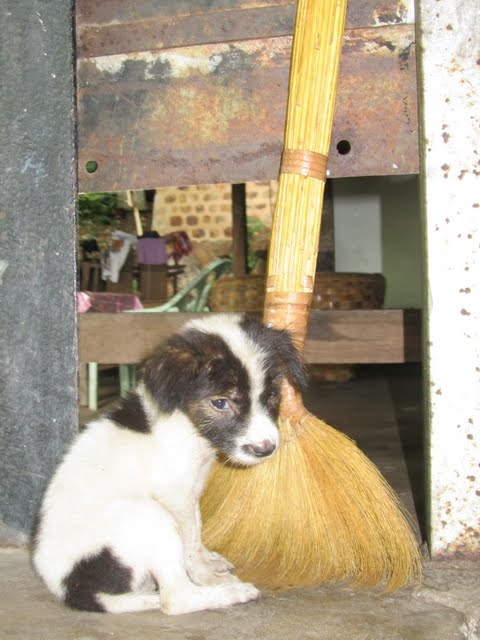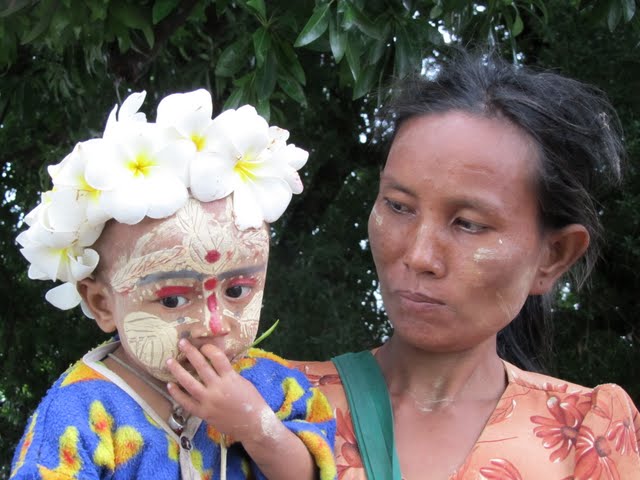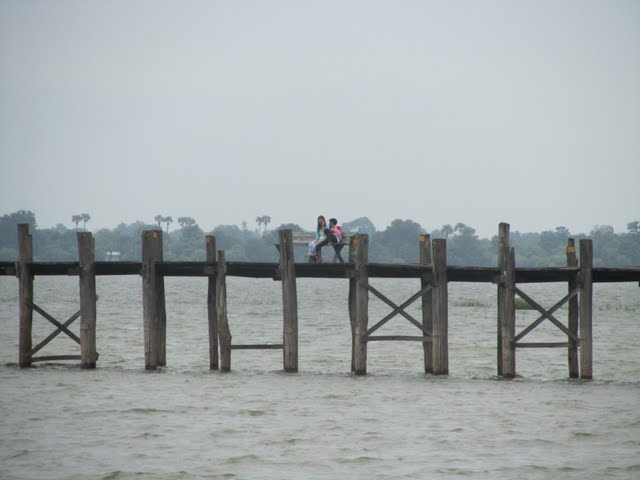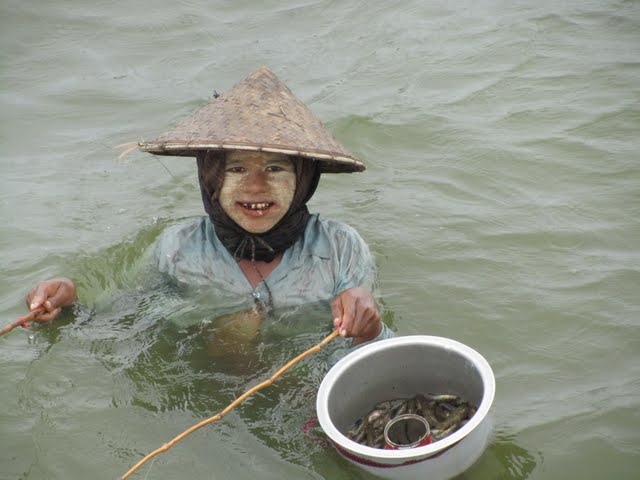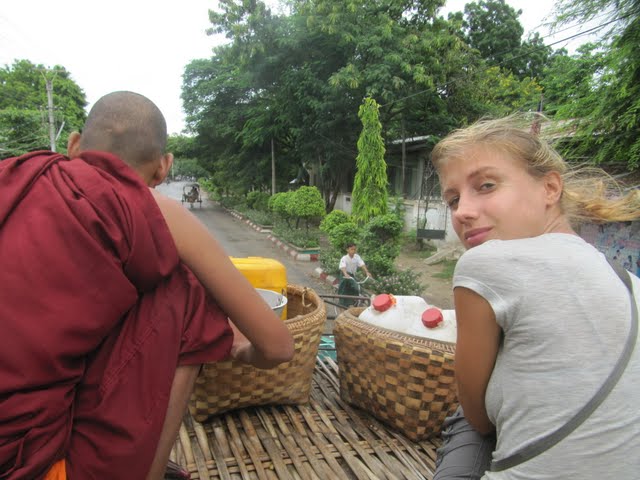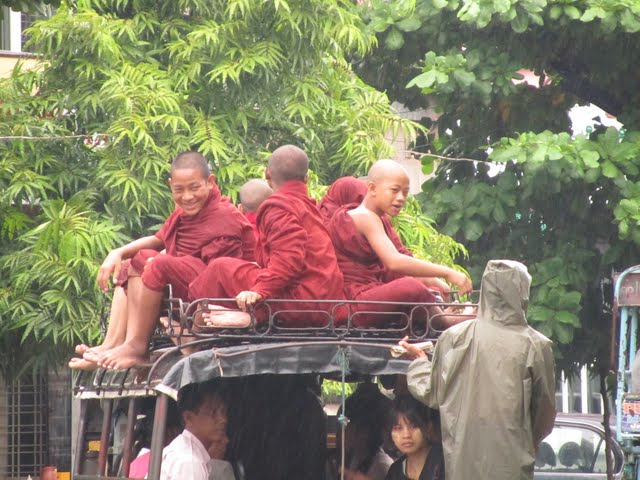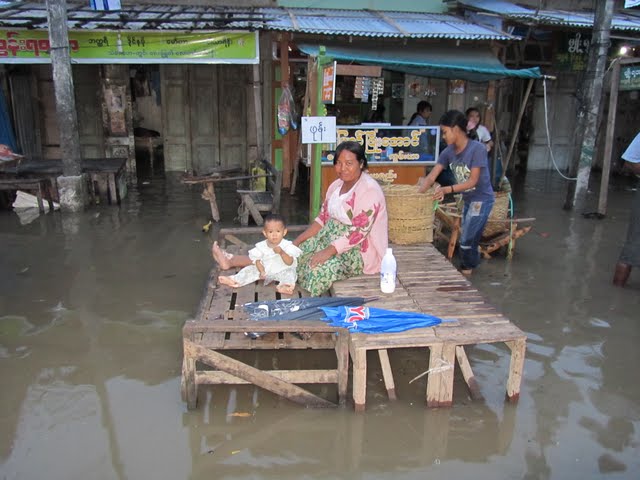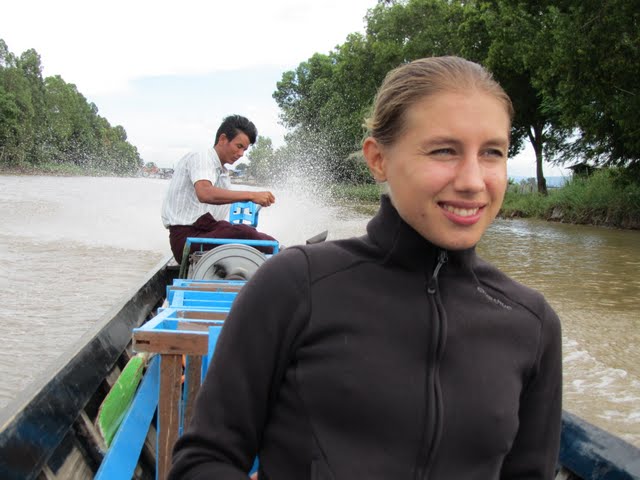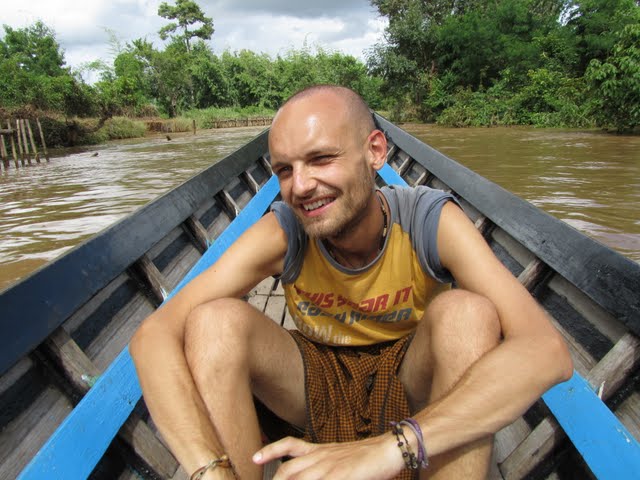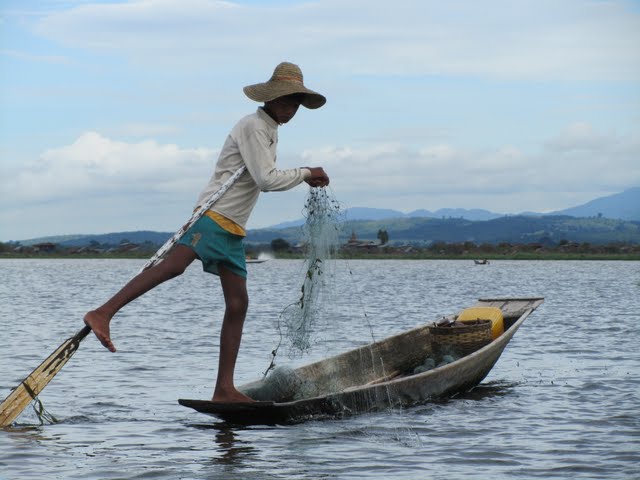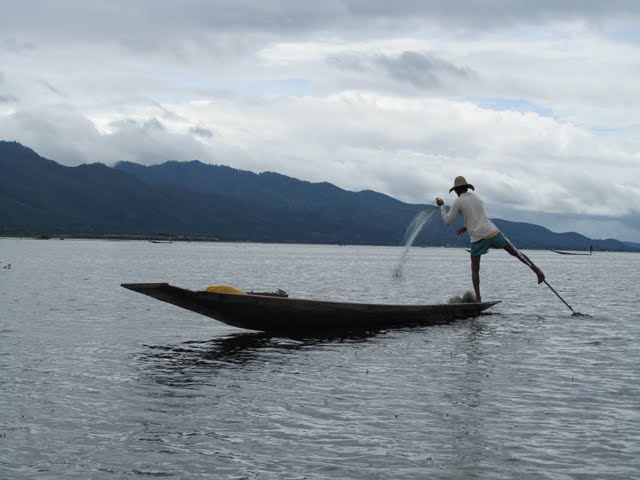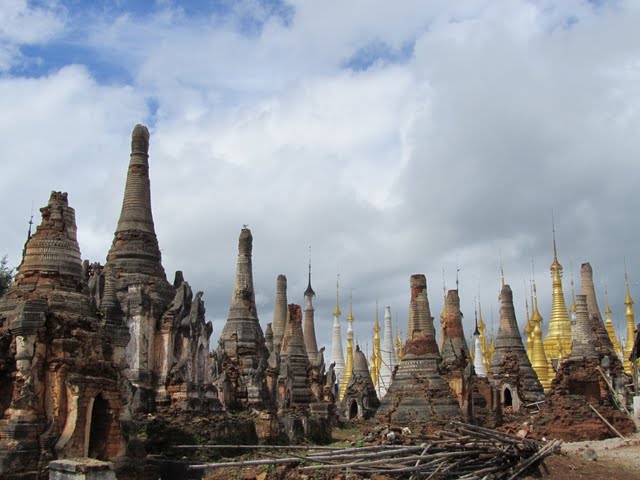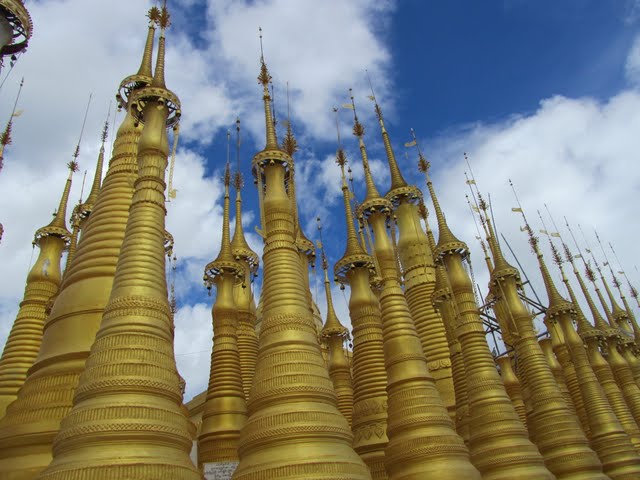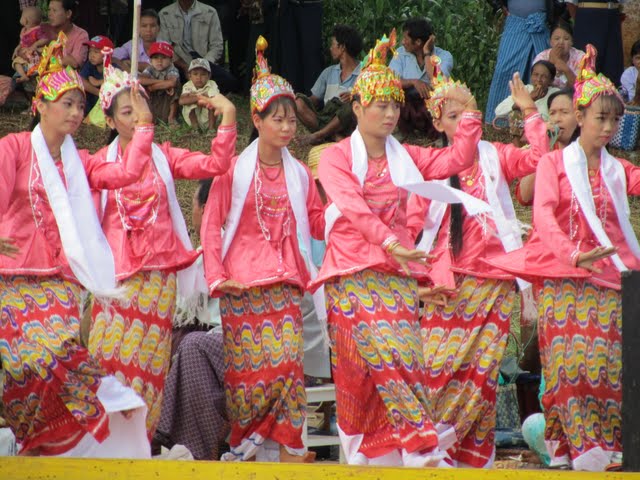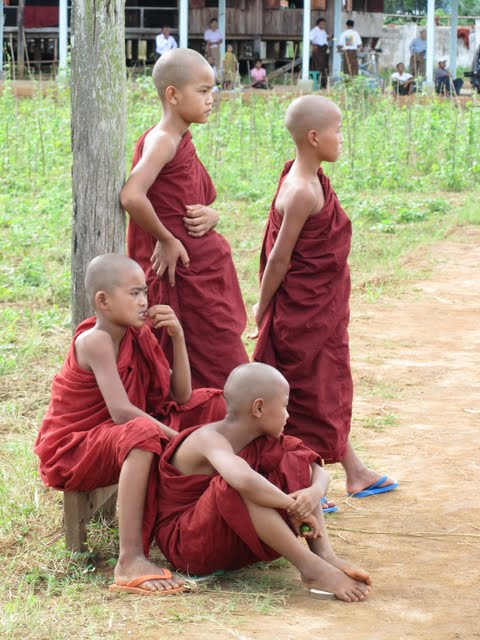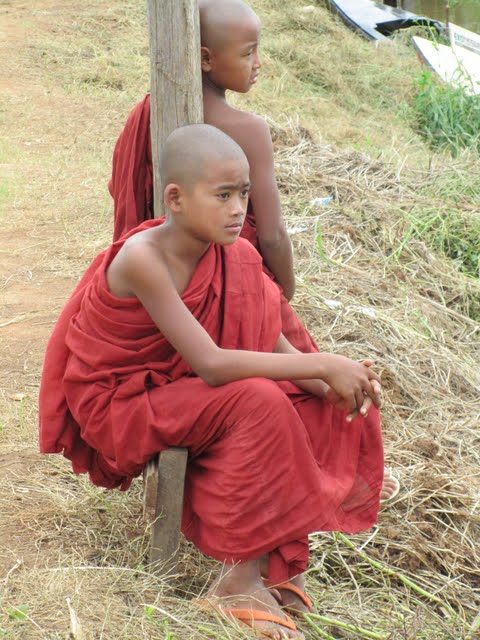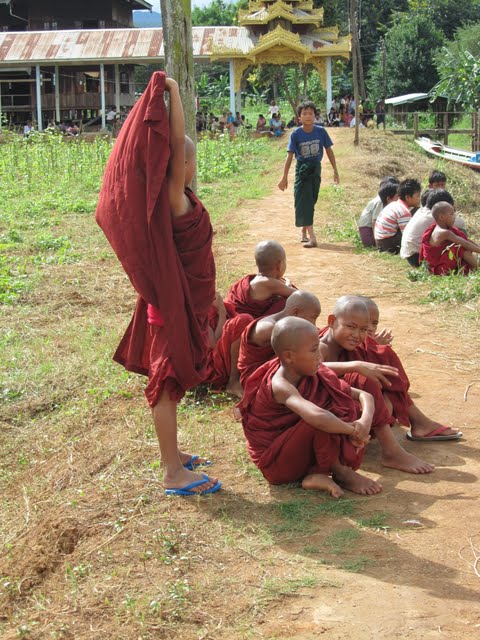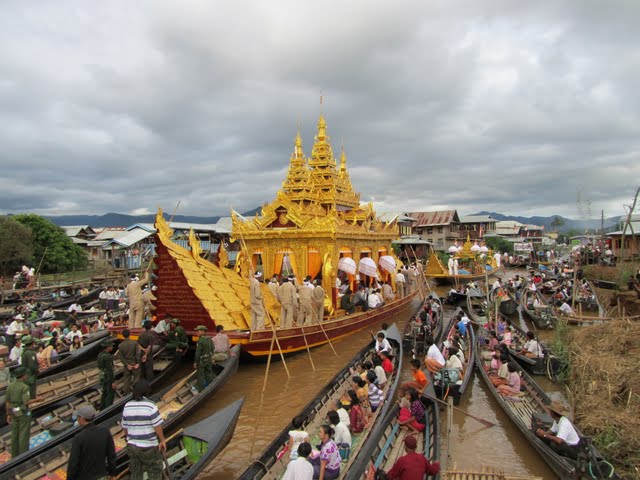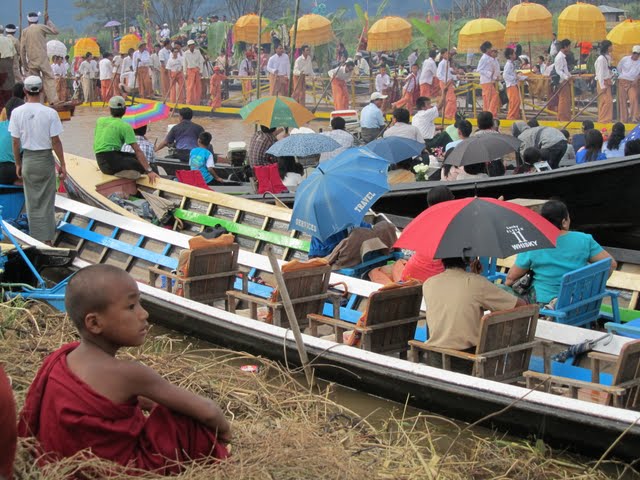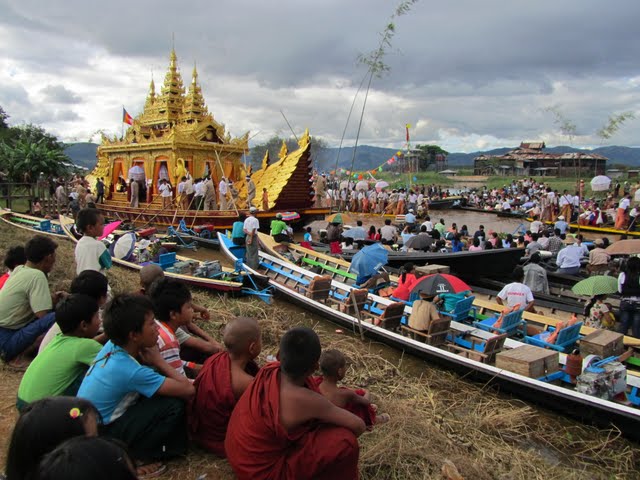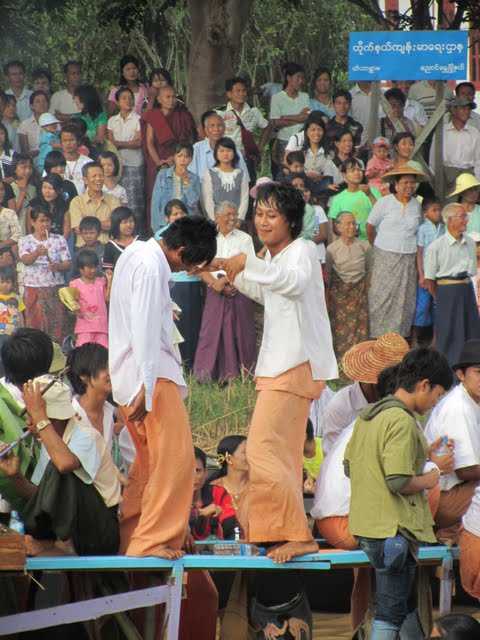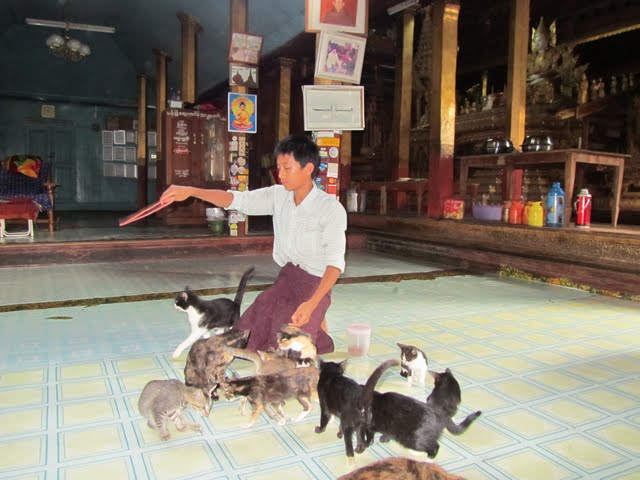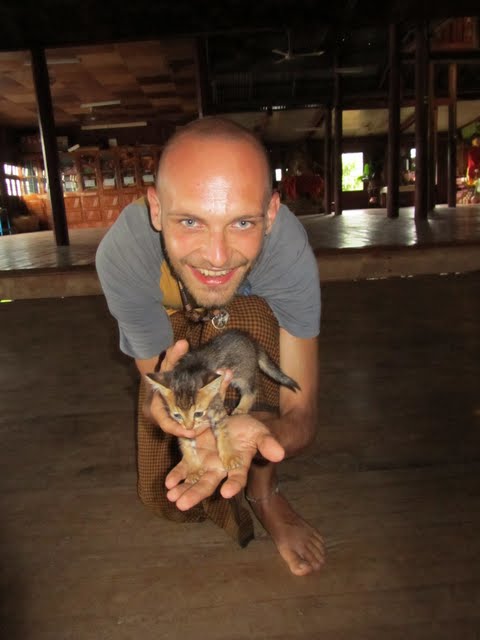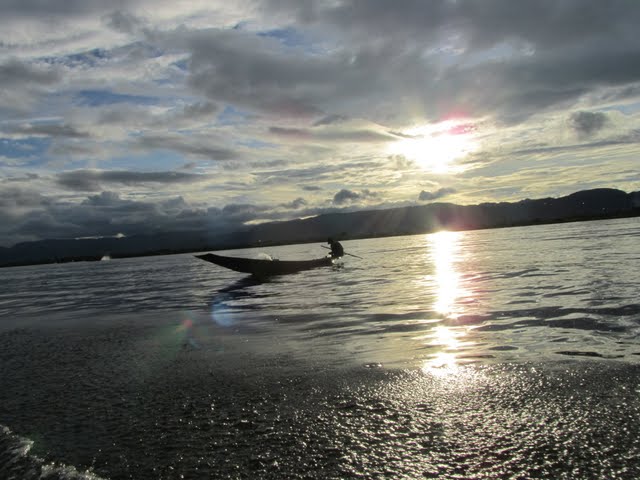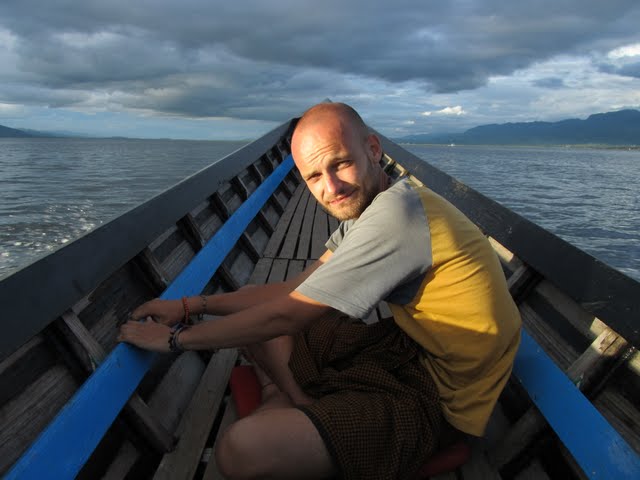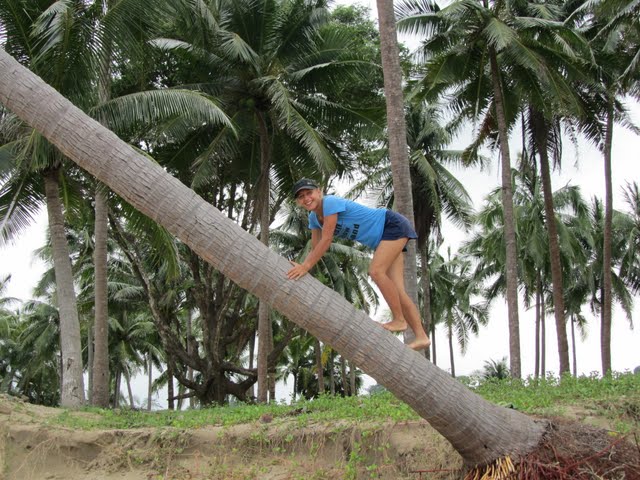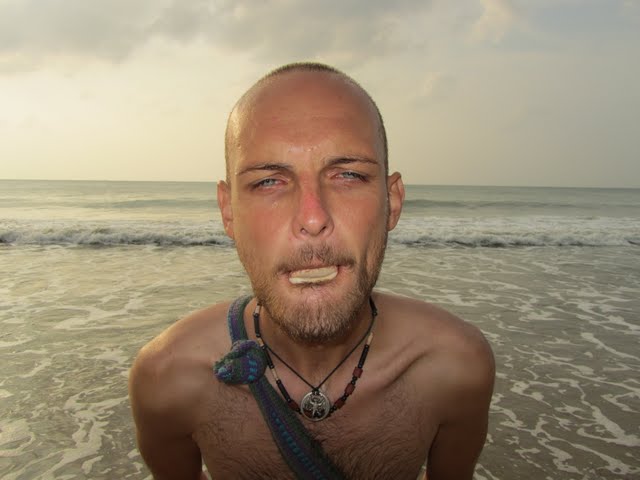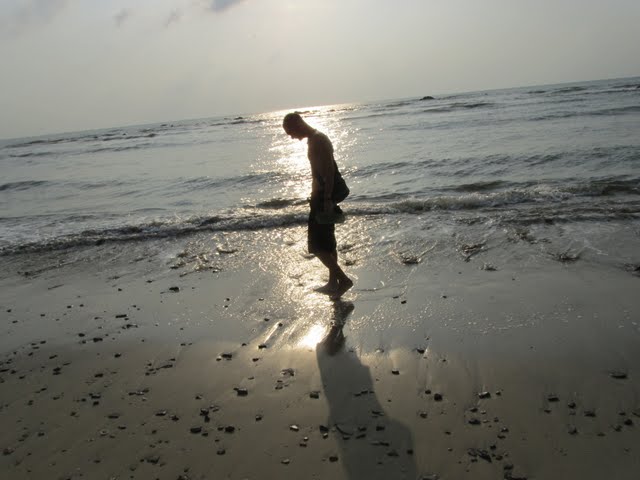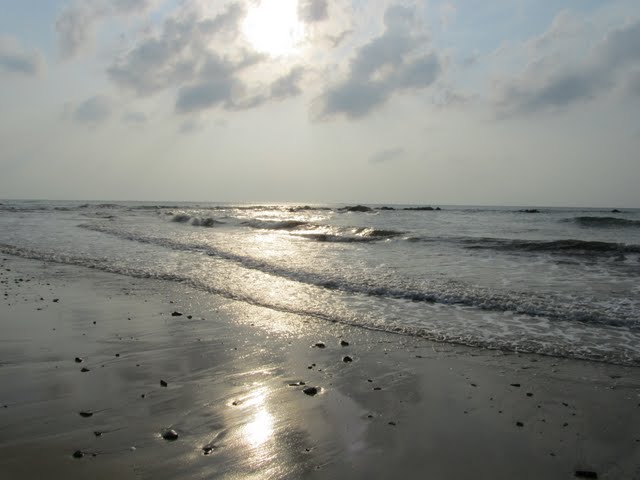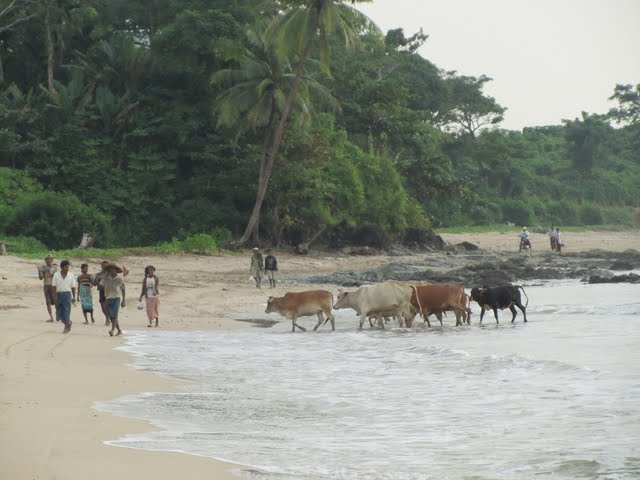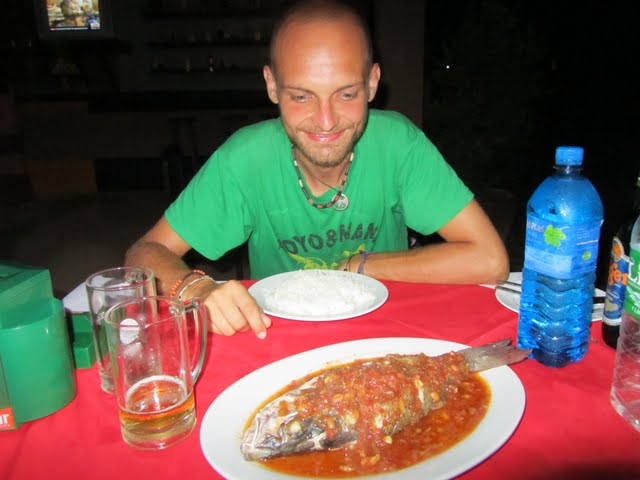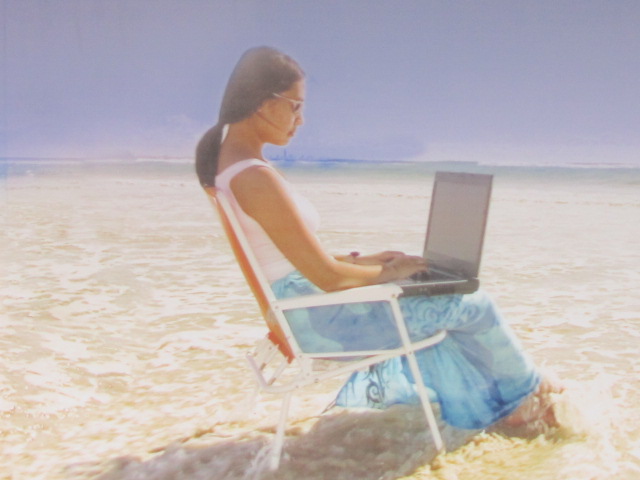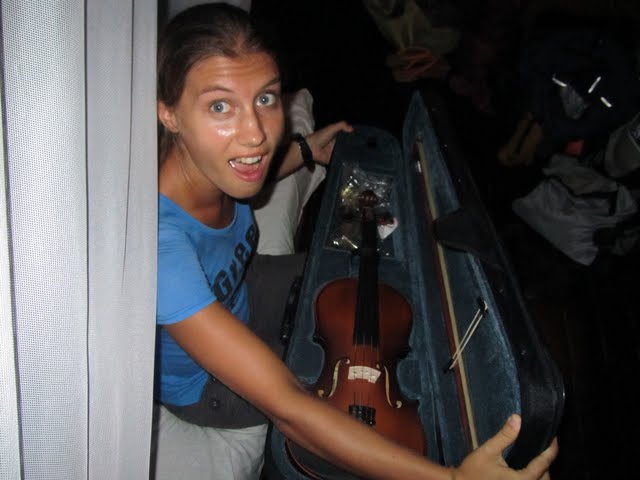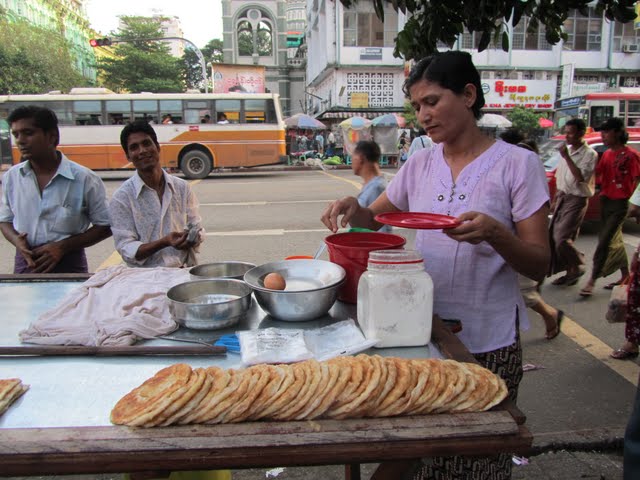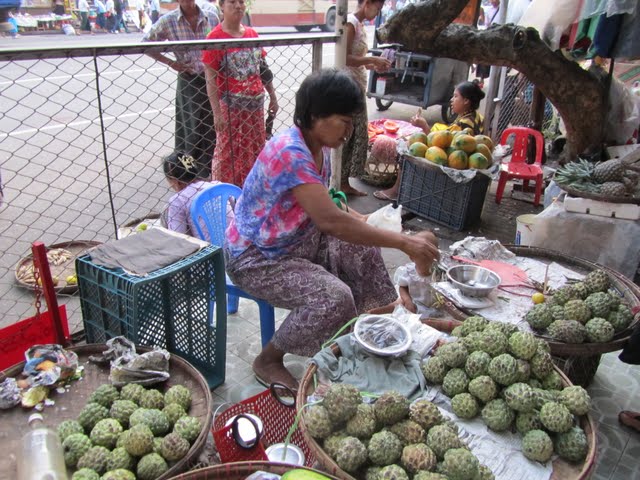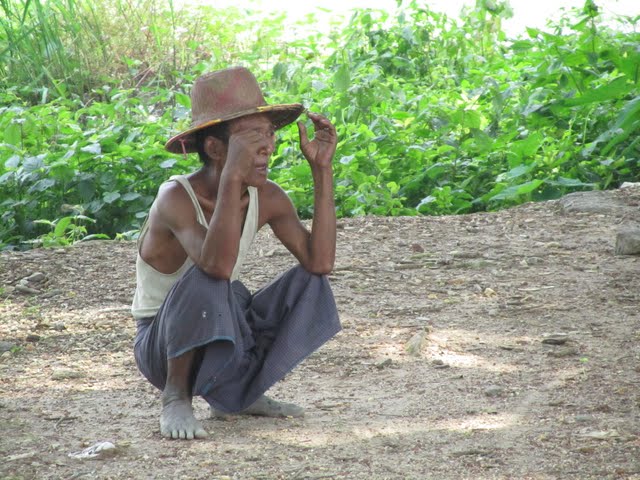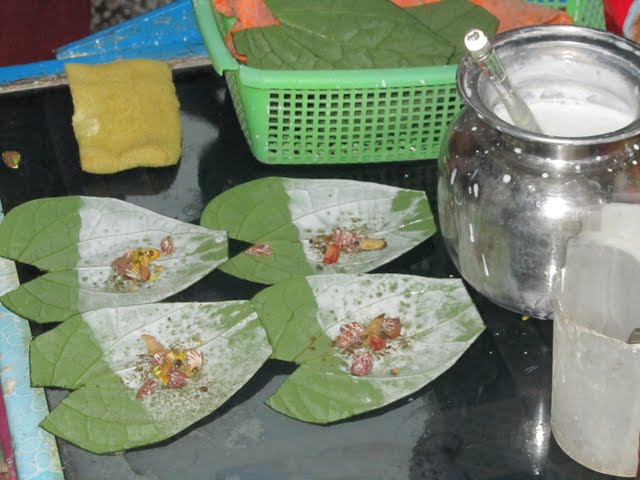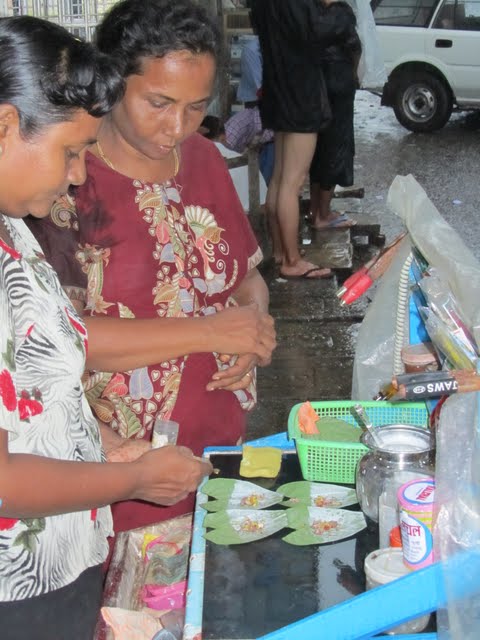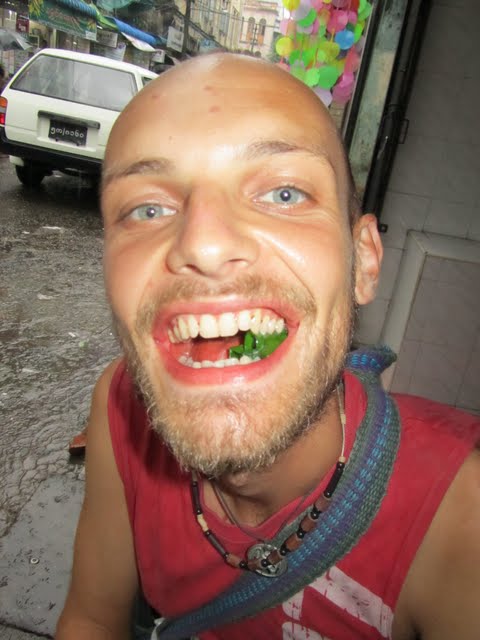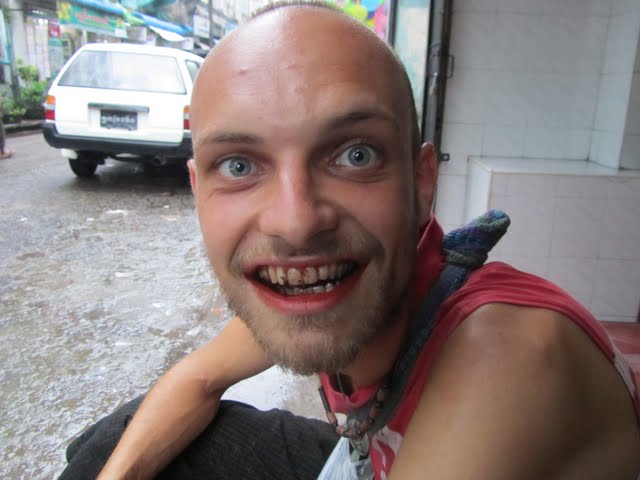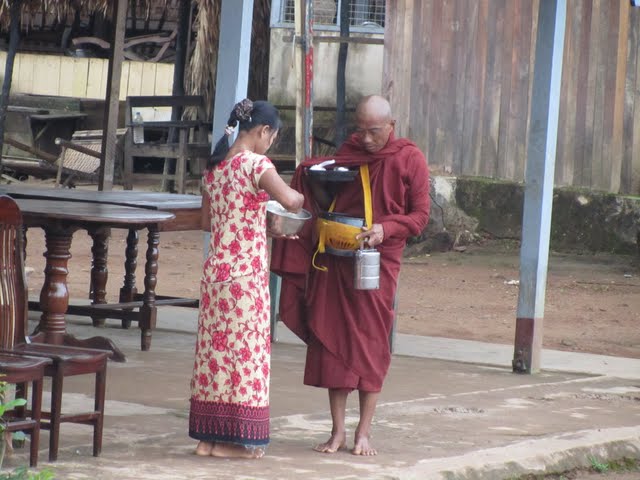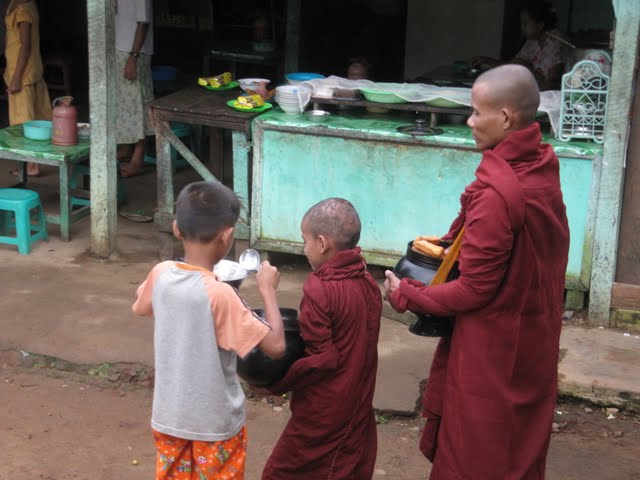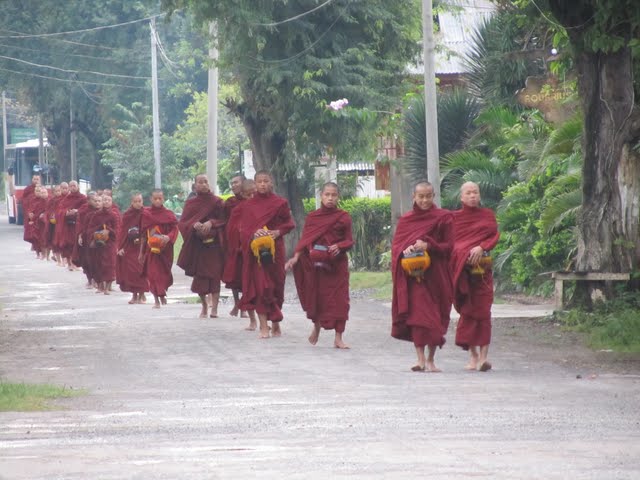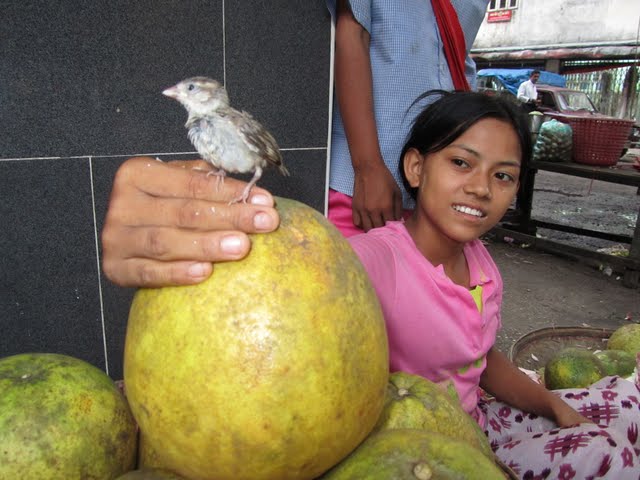Myanmar - the country of beautiful sunsets and kind people
First impressions
We saw the country for the first time from the plane and what struck us was how many golden “payas” we saw against the very neat and very green rice fields. Later we would see that that’s what Myanmar is about – simple but charming beauty of the landscapes, lots and lots of golden “payas”, and very kind people who at any time look like they are going to carnival (you can see from the pictures why).
The immigration was very easy, as there are very few tourists in the country compared to the rest of Asia. We took a taxi and on the way to the city stopped at a hotel to change some dollars into kyat. Something anybody going to Myanmar should know is that there are no ATMs, no one will want credit card payments, so you have to bring the full amount you would need for the country in cash and – here comes the best part – all of it in new, clean bills (100-dollar ones have higher value in the market but you also need small ones for the hotels who accept payments in USD). We were warned by a fellow traveler to make sure the bills we bring are not bended and very clean, in short - new. So although we had some pretty new dollars but they had been in a roll so were a tiny bit bended, we had to buy new dollars in Nepal.
When we had our first change encounter we figured that they are a little less paranoiac about the state of the dollar bills than what we imagined and although they want “new” bills, the correct definition is “reasonably new”. This whole “new dollar bill” thing is especially funny in the light of the fact that the bills of their own currency – kyat – are in such appallingly dreadful state that many of them are physically falling to pieces, so these people keep repairing them with sticky paper, or permanently put some of them in plastic bags, or staple some of them together, and the list goes on and on with no limit to people’s imagination… Another thing about Myanmar money affairs is the dollar rate – there is the official rate but it’s only half of the rate of the market so that’s where everybody changes. In our first exchange experience they gave us a very good rate but in the end somehow managed to convince us that the bills we were giving them were fine but the series was the one that was valued a little less in the market per each bill as the “Koreans were flooding the market with the same series”. Of course the story didn’t stick but somehow we got so relaxed under the charm of local people that we totally fell for it :( - no big harm done (we lost something like 5 USD), but if anybody ever goes to Myanmar don’t let them fool you!
The first 2.5 days we were exploring Yangon – this former capital of Myanmar (in fact we never visited the official one). We stayed in a Japanese-style hotel (with the Japanese elements in decoration and the befitting cleanliness which was the result of daily scrubbing performed by the three small kids who basically run the whole place on their own). The hotel was right beside the Sule Paya – a golden marvel in the centre of Yangon’s main roundabout.
We started our first day in Myanmar by shopping for a longyi – that’s a local name for a piece of cotton cloth that Burmese men and women alike wear in shape of a long skirt tied around their hips. Guess what – it wasn’t me who wanted the skirt :) - it was Jordi! Since he saw men in skirts back in India, he had become infected with an idea of wearing one, and he even bought one in India but never had a chance to wear it. When he read in the Myanmar guide that everybody wears a longyi there, he had a strong determination to join all the males of this country in their dedication to skirts. So we got one, and later another one, and another one, and … well, I stopped counting but I think we started a collection of longyis and later on are planning to expand it in Indonesia and maybe some other countries where they wear longyis. But acquiring a longyi was very simple compared to the trouble that followed next – trying to put it on, as for something that looks so simple it cost us a few days of asking every single male in the street how they do it, getting tips and help, and a lot of practising on Jordi’s part. The problem was the very special knot that they make by energetically throwing the sides of the longyi towards the centre, grabbing it on the fly and fixing it in some kind of weird (and bulky) construction. I think Jordi eventually got it after a week of suffering and continuous risk of losing his lower piece of clothing in the middle of the street. But once he got it, he even figured out some tricks of his own for how to make the “skirt” stick around his hips (the knot though never became as neat as those of the local guys, but after all they do it since they are small boys).
Yangon and its incredible pagodas
Anyway, in between all the knot fixing we still found some time to visit the city’s main attractions that is the golden “payas”. The most known and impressive one is the Shwedagon paya but we started with the less important ones to be able to “savour” the best one later. So we visited the Maha Vijaya paya – that one was very charming and in fact we kept coming back to this one on the days that we were transiting through Yangon and had some hours before the bus, as it was the most peaceful one and for free as opposed to Shwedagon. It was our first encounter with the material manifestation of the Burmese Buddhism and by a funny coincidence we had a proper introduction by a young guy who seemed very eager to talk to us about the Burmese flavour of Buddhism. We already knew from LP and now confirmed it by talking to that guy, that in Myanmar they are followers of the Theravada school as opposed to the Mahayana school elsewhere in the Buddhist Asia. What it basically means is that they try to follow the original Buddha teachings of the Eight-fold Path and Vipassana meditation and are quite skeptical of the blind worshipping of Buddha as God by Tibetan folk and their daily practice of swirling prayer wheels, the “abs exercise” and yak butter donations, which the Burmese consider a distortion of the original Buddha teaching. In my viewpoint the Burmese do indeed have the purest approach to Buddhism and I was quite amazed to realize that in this country meditation is a daily norm and people come to payas to socialize through prayer-like meditation!
After the Maha Vijaya paya we also visited the Chaukhtagyi Paya with a very big reclining Buddha statue and had a glimpse at Ngahtatgyi Paya. Next day we visited quite extraordinary Botataung paya – the only paya in Myanmar which is hollow inside. It is a maze-like structure of gold and sparkling glass in which you start and finish at a striking altar enshrining the sacred Buddha hairs. We couldn’t see the hairs of course but felt duly impressed by the fact that they were there, resting in a crown of huge jewels and gold.
Shwedagon. Point.
Next attraction on the list for that day was the Shwedagon itself, but on the way to it we passed through the Bogyoke Aung Sang market and on our quick tour through it found a music shop where they were selling violins for a funny price of around 60 dollar. I tried them out of curiosity not expecting anything much for that money but they turned out to have a pretty good voice so … well, more on this later. We timed our visit to Shwedagon around the last few hours before the sunset to be able to see it in all its shiny glory in the mellow twilight. We read and heard a lot about it and were quite prepared for something impressive, and so it was, not in the lightning-strike manner but rather very charming and with a long-lasting “after-taste”.
As you enter this paya from one of the four entrances, after a very long staircase full of souvenir shops you leave your shoes in the ordinary world behind and step onto the white-tiled floor of the extraordinary world in front with the amazing golden paya as its epicentre and lots of small payas and meditation chapels along the perimeter.
In a few hours that followed we did I don’t know how many circles around the paya, meditated with the locals, talked to some monks, got hungry but had to keep swallowing our saliva as we were watching the locals eat their picnics (we didn’t have any food, they didn’t sell any on the premises and we couldn’t exit to buy any since the ticket office had a huge warning “one entry only”).
Anyway, we stoically waited till the sunset time and then it was a spectacle of ever-changing impressions as the paya was emerging in ever-changing lights, “showing off” its 4351 impressive diamonds (the biggest one as impossibly big as 76 carats). The freelancing guides were fishing tourists - one of them was a charming retired guy who was now and then “running into” us, now suggesting taking a photo, then offering some viewpoints. Eventually around sunset he brought us to a very specific point where we could see the biggest diamond creating magic lights around the crown of the paya in rainbow colours. That was it for that magic-filled day.
Bago and a nice motorbike tour by local taxi-drivers
Next day we left for Bago which was our stop-over on the way to the famous Golden Rock. Something else you need to know about Myanmar is that since it’s a dictatorship, LP strongly promotes paying as few fees to the government as possible (quite controversial approach but ok) so an option they were suggesting for exploring all the multiple city sights was avoiding the 10-euro governmental fee and hiring local motorbike taxi drivers to drive-guide you thought the city, as supposedly that would spare you the fees. After some hesitation and bargaining with a couple of drivers who seemed like nice guys, we managed to convince them to make it half the usual price (they seemed very happy anyway) and off we went to check the long list of attractions.
First we visited a very huge Kha Khat Wain Kyaung monastery (in case you are wondering, I am not spelling it out of memory – I have to copy from LP every name in this impossible language). We saw a lot of studying monks who were trying to pretend they are not noticing us as we were pretending not to be curiously staring at them while registering some of their stealthy looks on camera :).
Then we went to see the so-called Snake Monastery the sole attraction of which was an 118-year-old (in human equivalent) female python who according to the story is the reincarnation of the woman who started building a pagoda in Bago and died before finishing it. The story gets even more curious as even in her reincarnation as python she was quite determined to finish the pagoda so she came to the area of Yangon and stayed close to people who quickly realized that this giant creature was harmless. Somehow she managed to communicate to them her desire and was brought to Bago and stayed in that monastery ever since. I felt that she does eradiate an incredibly strong aura of peace and wisdom, but maybe it’s only me…
Then we visited the Shwemawdaw Paya, which according to LP was supposed to be of “washed-out” gold. Well, when we were visiting this highest paya in Myanmar, they were busy replacing the washed-out look by putting fresh golden leaves which apparently takes place every 4 years and is supported solely by donations (read – not government). As we were wandering around making sure we don’t approach the side where the official fee was levied, we could watch the breathtaking work of local guys who were replacing the gold standing on thin bamboo constructions at an impressive height (after all, it’s the highest paya).
Then we visited the Shwethalyaung Buddha (the prefix Shwe in every name means “golden”) – a huge reclining Buddha statue with a very romantic story behind it of how a Buddhist prince fell in love with a pagan girl and how his dad wanted her killed and how she prayed in front of a Buddhist statue and then it cracked from her powerful prayer, and how the king was so amazed that he spared the girl and built a new statue in that place. In Naung Paw Gyi Mya Tha Lyaung we saw a huge statue of another reclining Buddha wearing red garment. In Maha Kalyan Sima we checked the statue of 4 Buddhas standing with their backs to each other, and saw a lot of school kids playing on the premises. And as it was about to rain very hard and we were quite saturated on the Buddha statue impressions we called it a day.
In the end it didn't rain so we had time to check the local market and look at all the amazing merchandise that locals were selling and buying from each other.
The fabled Golden Rock
Our next destination after Bago was Mt Kyaiktiyo, more known as the Golden Rock. From Bago we took a bus to the big Kyaikto village and after that a pickup to the “base-camp” village of Kinpun. As it was pretty late to start the hike we hang around doing nothing much – just watching the locals in the street and reading.
Next day it was raining very hard so we were thinking whether it would be possible to hike to the summit that day (the guide was warning that it could potentially become very slidy) but in the end we took our chances and started going up. In the end it turned out to be very doable and some locals (including a monk) were doing it in their flip-flops.
It was a 4-hour hike up in quite annoying rain but on reaching the top we were duly rewarded by a glorious sunshine.
The Rock (which is so famous because it balances on top of a platform at a precariously curious angle with supposedly only as much as a hair of Buddha keeping the whole thing in equilibrium) was also duly impressive and we stayed there as long as possible into the twilight hours to see the gold change to a gentler and more impressive shade. After that we had to catch a pickup down which brought us all the way back to Kinpun in an insane time of 20 minutes as it was driven by an equally insane driver.
Mawlamyine - laid-back city with impossible name
From Golden Rock we needed to go to Mawlamyine (I still don’t know how to pronounce this name correctly but trust me, whichever pronunciation you think it is, you are very, very far from the real one). One more thing you need to know about Myanmar is that here they have a very unique pricing model for bus tickets (trains are available in this country with quite straightforward rates for foreigners but are much slower and more expensive so off the list of transportation options). I am sure these people haven’t read Kotler but they did figure out that differential pricing is key, and elaborated it by making it double-differential (hence the uniqueness): first, they apply exactly double rate to foreigners as compared to locals, and second, the farther you get from Yangon the higher the prices go, not following any kilometer/hours logic but rather what they could charge. So for instance, a 4-hour drive from Yangon to Bago cost us 1000 kyat (about 1 dollar) but the price for the same amount of hours and kilometres from Golden Rock to Mawlamyine was quoted at about 8000. In the end we decided to go the “local way” which was taking a pickup - a minivan with two parallel wooden benches. It made it about half that price but we did have to switch a few times and in the end had some very sore places on our body (one of them being the neck and the other one is quite obvious taking into account that the width of the bench is about 20 cm max and it’s not padded). Uncomfortable as it was, the slogan of this trip is “try to do as much as possible the same way that locals do it”, so there we were squeezing into yet smaller space as they were loading the pickup more and more as if it was made of rubber (quoting LP, “somehow the pickup is never full according to the driver”), and trying to breathe through the fumes, and changing to yet another pickup (they only work on fixed stretches but the first driver who picks you up passes you over to the next one with the bags and everything).
Well, back to Mawlamyine – we arrived there after 5.5 hours of the unforgettable pickup experience. This former capital of the British Burma turned out to be a very nice city consisting almost entirely of one long street stretched along a huge river.
Since we arrived quite late we only had time to go see the city a bit (the main activity centers around its market) and after that to enjoy the view of one of daily special Burmese sunsets from the Kyaikthanlan Paya, which being the tallest one is the best sunset spot of Mawlamyine.
Ogre Island trip
Next day we decided to make a trip to the so-called Ogre Island (Bilu Kyun) – well, we didn’t see any ogres there but met a lot of friendly locals. We started the day by waiting a few hours on the upper deck of the ferry that was supposed to depart at 9 and left at 11:30 instead (despite what both LP and the ferry guys told us). We were not sure whether we had time to do anything as they told us the last ferry back was at 13:00.
We needed to get back the same day since no foreigners are allowed to sleep on the island (not sure whether the ogres become especially nasty in the presence of tourists but in any case this fits perfectly fine with the Burmese policy of making many areas of the country off limits to foreigners). Luckily enough we found out that there was a smaller boat leaving at 15:00 so we had enough time to check a few villages. We hired a horse cart drawn by a very funny tiny horse with a huge belly and took the only road there is between the shore village and those inside the island. It was a very enjoyable ride (except for the guilt feeling for making the poor animal pull the weight of the three of us) through very beautiful landscape of fields, lonely huts and tall palm trees framing the road.
After a while we reached the villages and then there was mutual “watching” – us watching the locals and them watching us, both sides mutually amused. Something curious happened as we were riding back – at some point of the way our horse kind of refused to go forward and kept insisting on turning around. After a few futile attempts of our driver to make it go, he explained to us apologetically (in body language) that she just had a baby and the baby needed to be fed back at home so she was trying to go there. He asked if we minded to let the mum feed the kid which we of course didn’t, so we drove back to his village where the whole lot of its inhabitants gathered around us like we were some kind of huge attraction as we stood there watching the mum feed the baby and meeting the driver’s whole family. In the end the villagers decided to replace the tired mum by a fresh horse and off we drove with a much higher speed and accompanied by the “bye-bye” cheering of all the friendly locals. It felt like a very special day…
Nwa-La Pagoda - incredibly balanced boulders
Next day we had a day trip to the “wonder boulders” of Nwa-la pagoda. This was advertised by LP as a sight less known than the Golden Rock but even more impressive since there were in total three stones balancing on top of each other in magic-like equilibrium. The idea was to get a pickup to the base in Kyonka village and afterwards – another pickup to the summit. But it wasn’t the first time that things had to be re-planned due to inaccuracies in this edition of LP and we found out that there were no pickups going to the summit so we had a 2-hour walk up and same thing down. Well, 4 hours is peanuts to us, seasoned trekkers, so off we went.
After a sweaty hike up with no water (we forgot to buy any) through solitary terrain we were finally greeted by a tiny calf at the entrance and later by a lonely monk who gave us a quick tour around showing the best place to admire the angle of the boulders (seeing which made us feel like staying as far as possible from the whole construction :)).
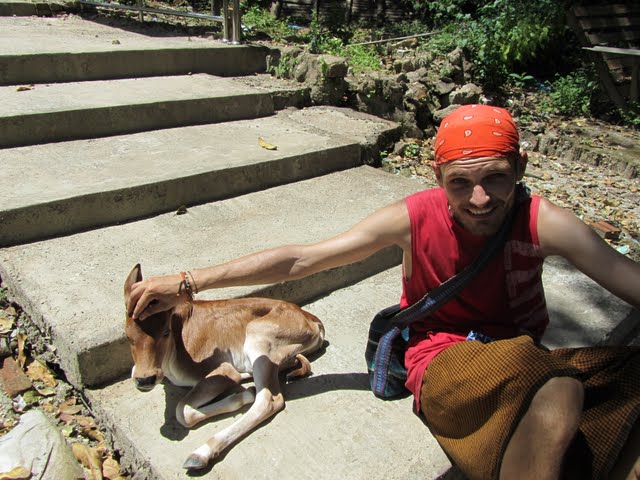
It felt like a very special place and we sat down to soak in the atmosphere.
Remember, I told you about the Burmese approach to Buddhism and how meditation is a norm of life and almost a way of socializing? Well, that day we witnessed something that was a total proof of it. As we were sitting there facing the golden rocks, a woman approached me, first offering a bar of chocolate, and afterwards saying in the most natural common-place manner you can possibly imagine “Let’s meditate!” Well, who could resist such a sweet invitation? I meditated next to her for a while (she turned out to be a very “strong” meditator which is probably part of the Burmese DNA) until Jordi gently pulled on my sleeve to attract my attention to the fact that it was time to leave. So we left her there, still meditating, with a very nice feeling of having been welcomed into the Burmese culture in such an authentic way. We have been quoting that “Let’s meditate!” ever since whenever we talk about Myanmar, with this short phrase summing up for us the essence of this wonderful country.
The next day we were planning to finally leave from Mawlamyine even though we were getting quite attached to this city and especially to the noodle stall run by some very friendly family who were treating us like royalty every time we came to eat their tasty noodle soup, and to one tea place in the market.
The guy in the picture below runs a noodle stall in the market and was such an amiable person that we kept coming back to him for almost every meal.
These pictures are from a tea place which we liked a lot. They serve all sorts of tasty bakery stuff.
We took these pictures in the market the day it started to rain very-very hard and we had nothing else to do but hide under the covers of market stalls and wait till the rain would pass. In the end all of us were rewarded by an incredibly beautiful rainbow that started right in the spot where we were sitting!!!
That day was Friday which according to all our sources was one of the two days per week when we could catch a boat to Pha-An (the ride to which was supposed to pass through some idyllic scenery). To our big disappointment at the jetty station we found out that that day no boats would go since it was some Buddhist lent which in this Buddhist country means “no work”. We had to replan our itinerary on the fly and in the end decided to skip Pha-An and go north. We left for Bagan, taking first a freezing air-con bus back to Yangon, spending a day there and then another long and just as freezing journey to Bagan.
Bagan - hundreds of payas
Bagan is a huge historic area built by a fanatical Buddhist king of Myanmar who in a long bow of construction frenzy built almost as many payas in the area as it has trees. First day we spent exploring the Nuang U village which is the access point to the Old Bagan area. Next day we rented bikes and spent the whole day checking the payas in the villages of Myinkaba and Old Bagan. We saw a lot of impressive payas built in a style quite different from the Shwedagon type – they all are made of red brick, with some covered with plaster and paint. Also unlike Shwedagon, the payas in Bagan are not round but have stairs-like levels so we could climb some of them and enjoy the view over the whole area.
In Myankaba we started in Seinnyet Nyima Paya where a local painter accompanied us to the top. In fact, we quite liked his sandstone paintings with that very typical picture of long row of monks with their alms bowls in their daily alms-collecting procession, and since they were very cheap and the guy told us such a genuine story of how he learnt the art from his granddad, we decided to acquire one.
Then we visited Somingyi Kyang and Nagayon payas (this one had a statue of Buddha in a very fancy bright red outfit), after that the Manuha Paya with a reclining Buddha statue so big that it seemed so close to bursting through the tiny room enclosing it; then the Gyubyaukgyi Paya – a small temple with another Buddha in a very fancy outfit. Here we couldn’t resist the temptation to buy another sandstone painting of the monks from Min Min - the guy who turned out to have the best style in town (we verified this later by checking the multiple monk paintings in every single paya).
As we were choosing the painting, another fellow painter of Min Min convinced us to contribute to him a symbolic 1 dollar of lucky money for a couple of small monk paintings. To make his pleadings even more convincing he was drawing for me small pictures of Burmese horoscope signs – a Lucky Elephant for the Buddha sign (people born on a Wednesday morning) and a Lion for me (born on Tuesday). Well, now we are so loaded with monk paintings that if any of you needs to fill a small space on some empty wall give us a wink.
In Old Bagan we visited Phatothamya paya where we talked to yet another artist who is so multi-talented (or multi-greedy) that he not only paints monks but also does tattoos (he tried to convince us to get one but we passed). Thatbyinnyu Pahto was a big white structure where a woman painter tried to sell us more monks. By that time we were very hungry and the only food option was some rice pancakes for me and lots of fried stuff for Jordi, which very cheerful and very bold local girls served to us in such a charming way that Jordi ended up consuming a lot of fried pieces, some of them as “presents” from these girls.
Shwegugyi Paya was very similar to the previous one (white and tall). Then we passed by the Palace en-route to the Mahabodhi Temple built with the same design as the original one in Bodh Gaya. In this one we had the funny encounter of the day, as a very smiley local woman with incredible natural marketing skills got hold of me and didn’t let go until I had my face painted with the bark-tree paste in the best Burmese fashion. What is amazing is how these people sometimes naturally figure out things that would probably be considered revelations in the modern marketing science. This woman for instance figured out that one of the most powerful purchase motivation can be our natural desire to reciprocate kindness so giving me something in the most genuine manner and not expecting anything in return would trigger me to be more inclined to check her merchandise (in the end we did get more inclined and got Jordi another longyi :))
A note on the bark-tree paste she made up my face with – in Myanmar women and kids (and occasionally young guys) always paint their faces and arms with this paste so in the end it looks like they are always going to carnival or coming back from some kids party. It’s partly a tradition but partly a very practical thing to do since it keeps the skin fresh and supposedly also keeps mosquitoes at bay (so a real panacea). The friendly woman insisted that I have a small brick of the paste so later I had a lot of fun drawing various patterns on my face – really, this country feels like carnival every day.
After that we visited Ananda Pahto – a very beautiful and very special temple with 4 huge standing Buddhas inside. We meditated there shortly since the atmosphere was so special and only stopped when interrupted by a huge group of loud Spanish tourists.
After that it was time for the sunset views so we headed towards one paya where almost every tourist in town comes to get the sunset picture of the trip because it’s so tall and has plenty of space on all its staircase levels (or rather because LP says it’s the best place). Actually the best sunset pictures were the ones we took before reaching this paya, and the paya was so packed with foreigners that you could definitely see every tourist who was staying in Bagan that day.
Since the idea of sharing the sunset with the huge multinational crowd didn’t exactly fascinate us, we left. It was very funny though how in a city where there are enough payas for every tourist to have one completely to him/her-self, they all (including us) came to the same one :). That day on encountering so many tourists and watching them in their sightseeing behavior it occurred to us that some people look so much like isles of their own country with kind of “glass shield” around them protecting them from any “bacteria of local culture”.
Mt Popa - the home of 37 nats
Next day we visited the so-called Mount Popa, the name of which will amuse any Russian speakers since In Russian “popa” is a gentle title for “bum”, but actually the name is a Sanskrit for “flower” – what a funny verbal coincidence. In reality, this theme-park-like “mount” is not really a mountain but rather a hill, and according to the local belief is the abode for 37 nats, or spirits.
We shared a pickup to this ghost-inhabited place with a Japanese guy and three local girls. On arriving there we found a long staircase leading all the way to the summit and a lot of nasty monkeys. We had a look around – more at the devoted locals praying to the spirits (it’s amazing how this nat traditions co-exist with the Buddhism) rather than the place itself which had nothing remarkable about it.
On our way back from the Mt Popa we stopped at the so-called Petrified Forest (or rather the two trees that we saw) and got really amazed by the trunks of real trees which somehow magically had turned to stones, and at a palm sugar workshop where we bought some very tasty palm sugar candy.
On our last day in Bagan we visited more temples in an area farther from Old Bagan and afterwards took a bus to Mandalay.
Mandalay - romantic name and huge disappointment
Mandalay… there is nothing that sums up the essence of this city better than the colorful description from LP (I am quoting from memory just to give you an idea): “For those who haven’t been, and the list includes Ridyard Kipling, the author of the famous Road to Mandalay (and as far as I am concerned – Robby Williams with his hit song), the very sound of this name brings the pictures of an idyllic Asian city of blissful peace and beauty but what it is in reality is nothing but an ordinary Chinese-like city with zero charm. Well, we had to verify it ourselves since the vision created mainly by Robby William’s song was too strong to discard just following some statement from LP, plus in the area we needed to check the world’s longest teak bridge in the world. So we came and stayed a couple of days, pretty much confirming for ourselves the LP description and also spending some time celebrating my birthday with a couple of local cakes.
Amarapura Bridge - the longest teak bridge in the world
The Amarapura bridge that we visited on our last day there was a very curious sight even in the annoying shower-like rain. Because of this rain we couldn’t take any decent pictures of the bridge but thanks to the same rain took some nice shots of the local women fishing from within the lake!
On our way back to the city we had a very exhilarating trip on top of a pickup – if you are in Myanmar this is certainly something to try!
A wooden oasis in a flooded street:
Inle Lake and the festival
The same day we left for the Inle Lake on a night bus to Shwenuang village. We arrived there around 5 am, after the usual Burmese stop for breakfast at 3 am (this is something they do on every night journey and you feel very annoyed on the first few trips but after that in the best tradition of our weird human nature you grow to like it). The one and only thing we wanted to do at this lake was to have a whole-day boat tour. They also organize treks in this area but after weighing all pros and cons we decided to skip it as we had already hiked a lot through roughly the same latitude in China, and through the incomparably incredible scenery of Nepal, and as to hill-tribe culture we already had had some encounters and would have many more in the countries to follow. So for the trip on the lake we found a local guy with a boat and started the tour after some breakfast in a local tea shop.
We were quite lucky as the timing of our visit to the lake coincided with the most important festival of the year that takes place on the lake and consists in their moving 4 golden “Buddhas” (basically, golden rocks) in a very spectacular procession of boats from place to place. We started the tour by passing local fishermen and admiring their incredible unique rowing technique (they wrap their leg around the paddle and row in S-es standing on the very edge of the boat keeping the hands free to handle the fishing nets).
After that we visited first a big pagoda and then a silver workshop where they showed us how they get their merchandise all the way from the mined stones to the final product. Afterwards we stopped at an umbrella workshop where they showed us how they make paper for the umbrellas and the umbrellas themselves. One of the attractions of that workshop was also the famous “giraffe” women – long-necked women of Paduang origin who still adhere to the tradition of wearing long collars on their necks, which in the past was meant to make them unattractive to men from other tribes and nowadays – to make the shop attractive to tourists.
Inthein and a lot of picturesque ruins
After that we “flew” (reflects the speed of our engine-powered gondola) through some lake villages and floating gardens and finally arrived in the village of Inthein where a real party was going on due to the festival: there were plenty of locals in the main temple, socializing, putting the golden leaves on the afore-mentioned boulders, eating and shopping at the especially active local market and all the corresponding happy chaos of a celebration.
In Inthein we visited a place with lots of picturesque ruins of payas and afterwards headed for a place at the lake where the main procession was supposed to pass some time afterwards.
The Festival
Having spent there a couple of hours among the monks and local folk listening to some frankly speaking awful local bands who seemed to be putting their loudspeakers to a volume test, we were getting a bit tired of waiting when finally things started to happen and we saw the big boat with the “Buddhas” starting to move and many many boats arriving with colorfully dressed people dancing and singing etc. etc.
It all lasted for an hour or so and in the meantime they managed to place the “Buddhas” to another boat, all very ceremoniously, and then all the boats passed and our driver was trying to steer us out of the “boat jam”.
Cats jumping monastery
After that we saw another monastery, also known as a Cat Jumping monastery for the corresponding trick performed by the multiple cats living there alongside the monks. We did see a lot of cute cats inside but were not sure whether we would be lucky to see a jumping performance. And then as we were almost leaving a monk asked me if we wanted to see the performance. I went to fetch Jordi and we saw a big group of Chinese tourists gathering around a teenage boy (we thought it was the monks who train them but it was this boy – what a surprise), and then we saw many many cats arriving to the spot. And then he was picking them one by one, raising a ring at a specific height and putting a treat on the other side of it to make them jump. Basically, there were two leading stars and a lot of beginners and it was a great fun to watch. In fact we got so jealous of their jumping cats that we are considering teaching the trick to our Baloo :).
After that we had a very peaceful ride back having views over gorgeous sunset on the lake.
Chaung Tha - escape the world
In our last few days in Myanmar we decided to treat ourselves to some beach and headed to Chaung Tha. We had to yet again pass through Yangon but were hoping to catch a very early direct bus to the beach. Unfortunately, by that time we ran out of kyat so we had to go to the city first and change some so by the time we got to the station we were only able to get a seat on a bus to Pathein – a big city on the way to the beach. We had to sleep there in the worst hotel ever (the fewer the tourists the lower the standards) and next morning were considering taking a local bus to the beach. But as we arrived at the station the very mean people there (in fact the only mean people you find in Myanmar are all somehow involved in the transport business) told us that the next bus was cancelled and another one would depart it three hours. Being the only bus company for that stretch, of course they asked for an insane (monopoly) price for this ride on top of coconuts (no, really the only bus we saw was loaded with coconuts and the guide was warning about this drive from Pathein as the most uncomfortable one where they put you on top of rice sacks). Well, we decided to pass on that coconut adventure and hired two motorbike taxis instead. The two young guys drove us to the beach through some very bumpy road but very nice landscapes.
We spent three wonderful days in Chaung Tha which is not exactly a white-sand postcard-like beach but is amazingly charming due to how solitary it is. Every day we swam and played in the big waves, now and then watching the monk kids play in the water at some distance and laughing at their sweet way of repeating our “water saltos”.
The second day we walked to the more remote beaches where it was only us and the waves and that’s where we stuck around for the rest of the stay.
Another great thing about Chaung Tha is the amazing food you can eat there for a very very great price. We were staying at Top Chaung Tha 2 resort which had the best accommodation in town (we checked a few before deciding) and the best restaurant as well. They cook the best steamed fish in the world – and this is in no way an exaggeration!
Last day in Myanmar
We were very reluctant to leave for Yangon but it was time to catch the flight so we left the beach (but we hope to come back some time) and spent our last day in Yangon shopping for more longyis for Jordi’s collection and… suspense, suspense… - a violin for me! Since day one in Myanmar I was thinking of getting a violin as back at home I only have an electric Yamaha one and the Chinese-made violins they sell here are pretty good. So I checked I don’t know how many of them choosing the one with the voice we liked best and – now I am travelling Asia with a violin. How is that for a little-luggage approach? :) After the awesome waves in Chaung Tha we are also considering adding a surfing board to the collection :), well, just kidding… The violin will eventually leave for Spain when Jordi’s dad comes along in Vietnam.
Next day we took a very short (less than two-hour) flight Yangon-Bangkok and that was the end of Myanmar.
Our impressions of Myanmar
To sum up our experiences, for us it was one of the best countries so far. It was very authentic, had the friendliest and kindest people on this trip and was just very-very charming, and of course, Jordi enjoyed wearing his longyi a lot. The food was great with quite a nice variety in the street stalls, but our all-time favourite is their fish noodle soup.
The bus system was very straightforward with lots of private companies offering the same routes so we had no trouble getting same-day tickets (the only nuisance was the foreigner prices policy). And the best part of this journey was our daily encounters with local people. They would always smile back at us with their betelnut-filled mouths, which in the beginning made their “bloody” smiles look a bit scary but after a short while became totally normal.
We were positively impressed by how much in this country is built on the solid foundation of sharing, which you see on a daily basis during the monks’ alms-collecting procession, with almost every person donating at least a spoonful of rice.
We would definitely like to come back to this country, and we even have this bright image of how cool it would be to have “an office” at Chaung Tha beach, with the chairs right at the shoreline, our feet bathing in the gently breaking waves and a vaio on our lap… (it might sound like a daydream, but after all everything in this physical universe starts with an idea, so we will keep on dreaming!)
